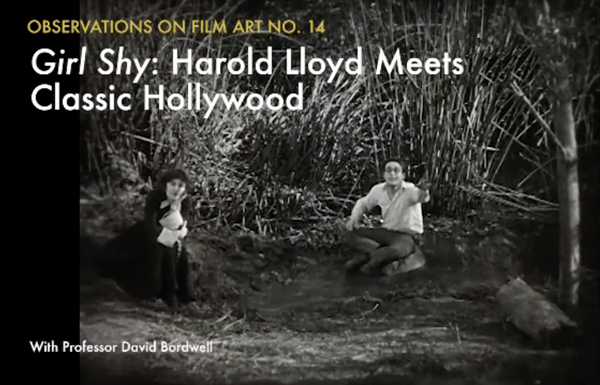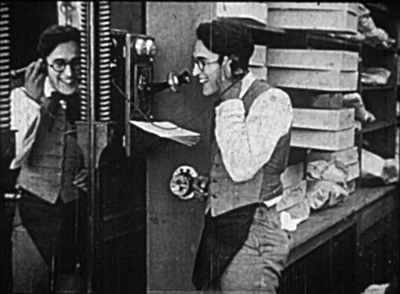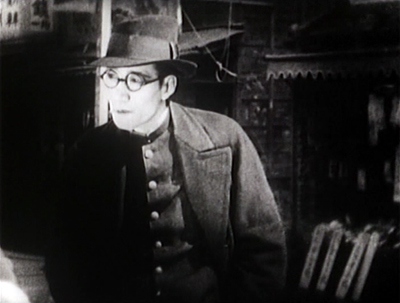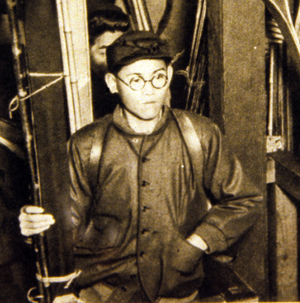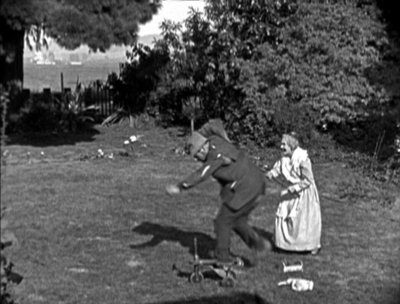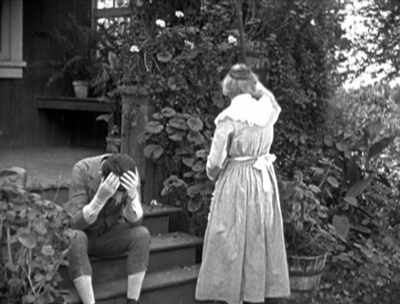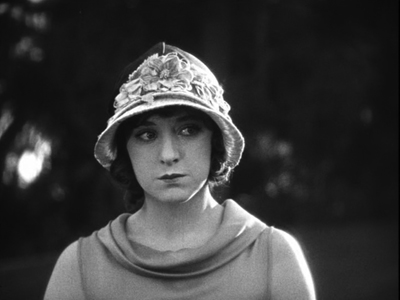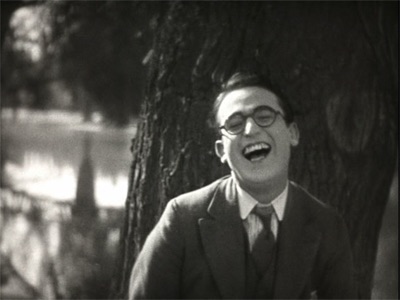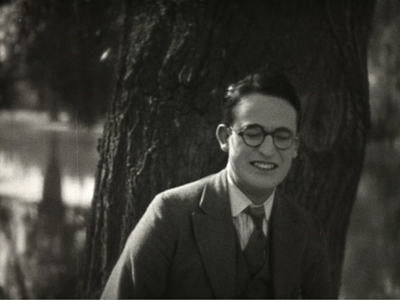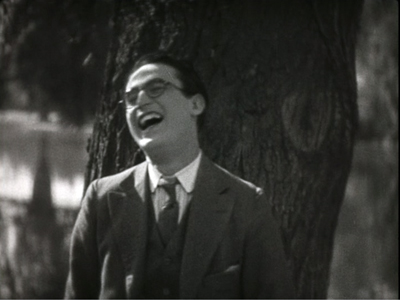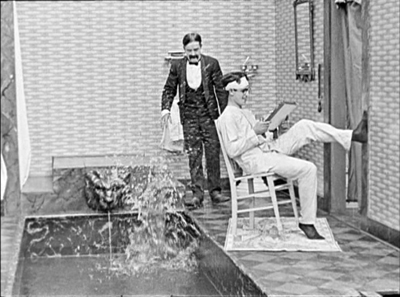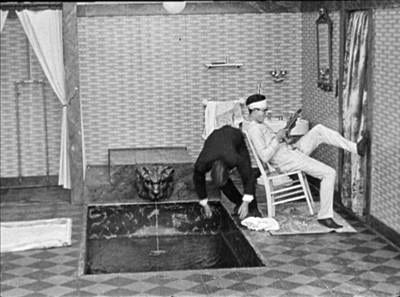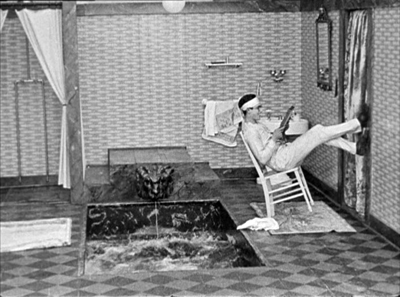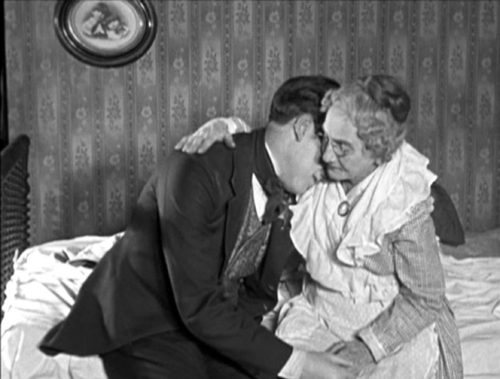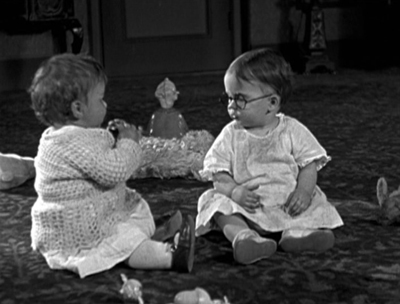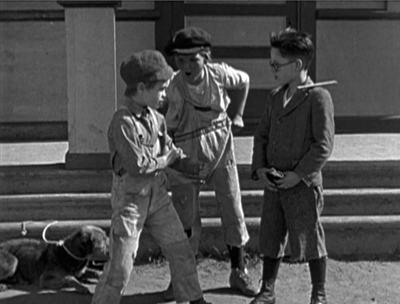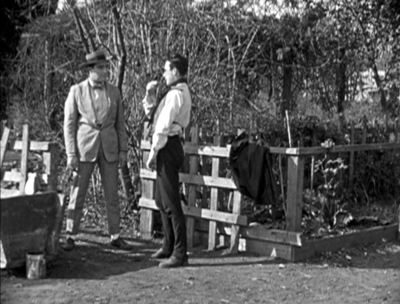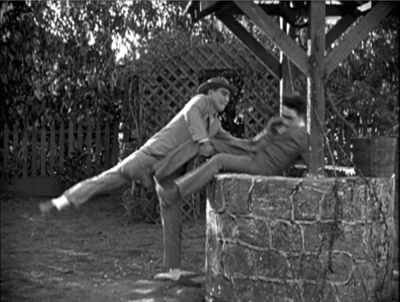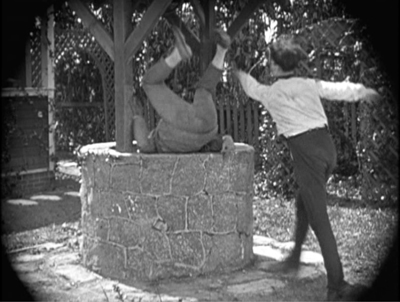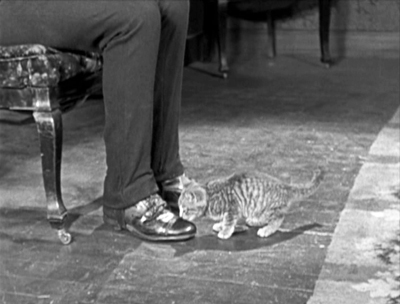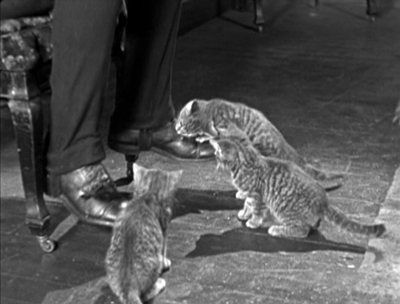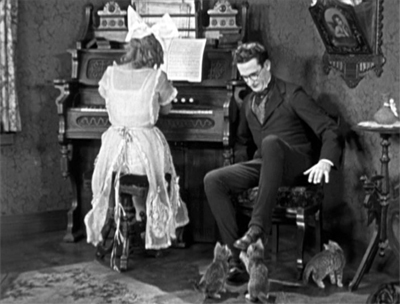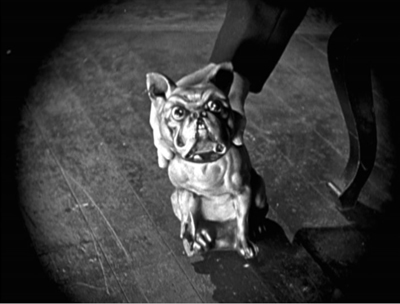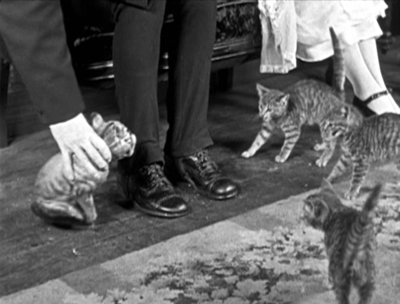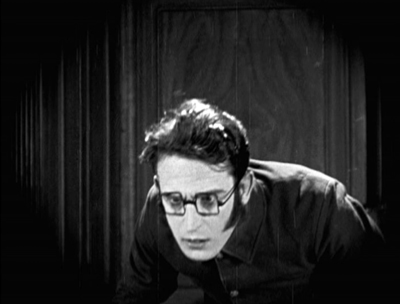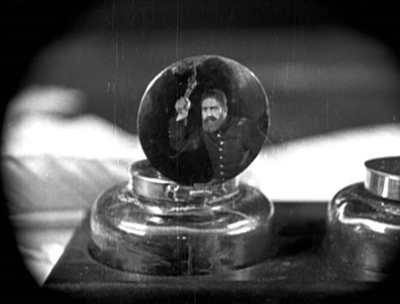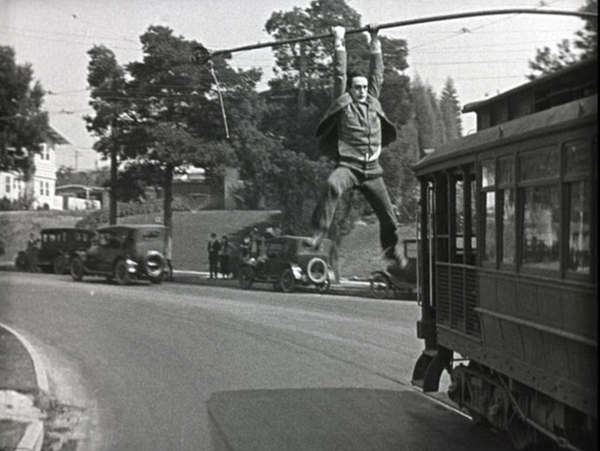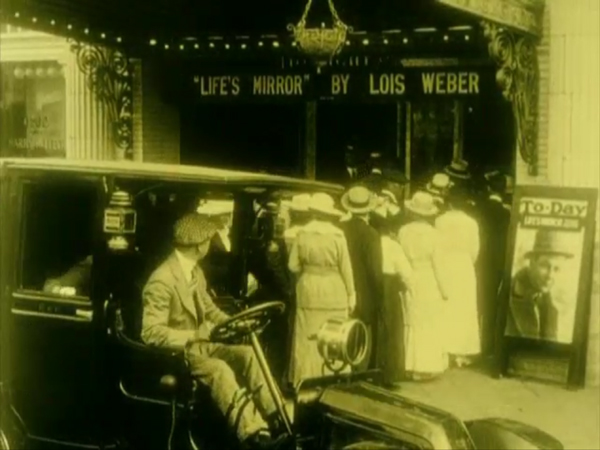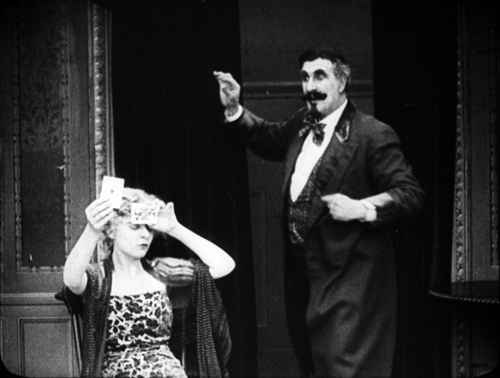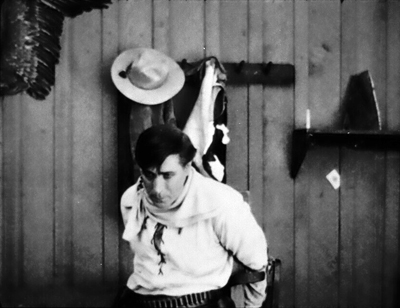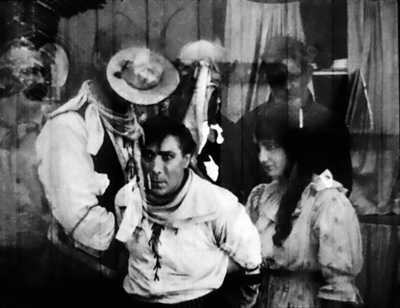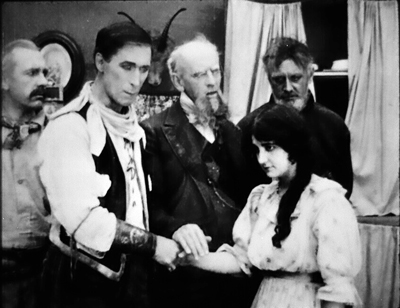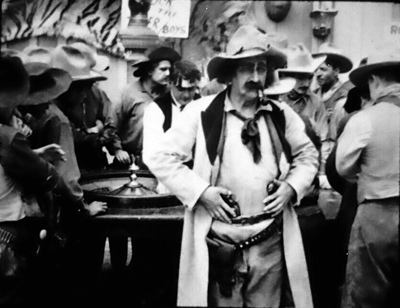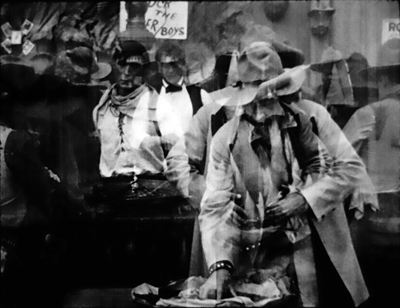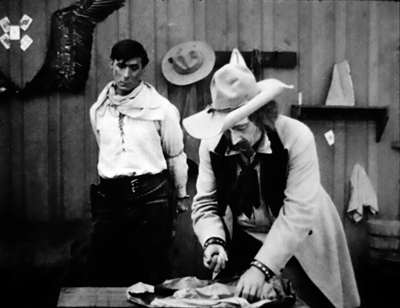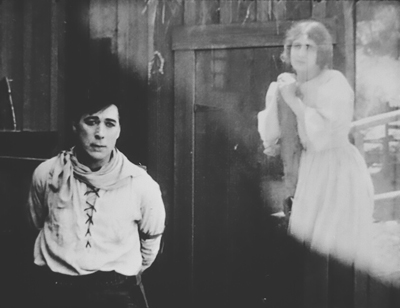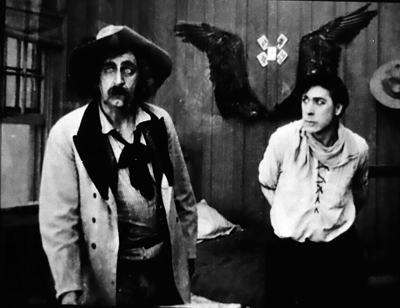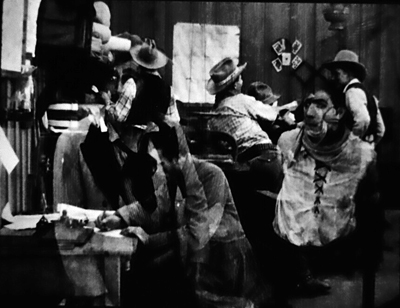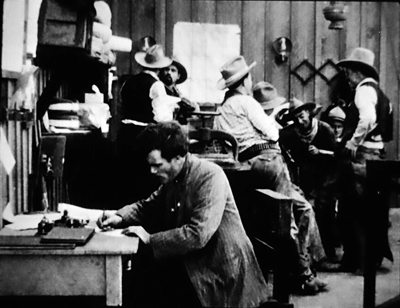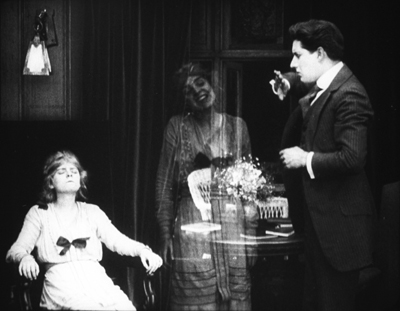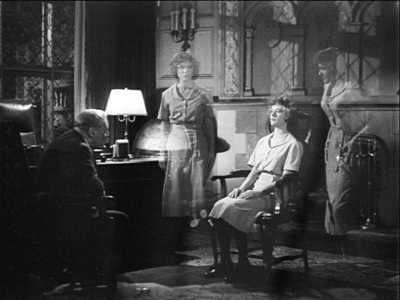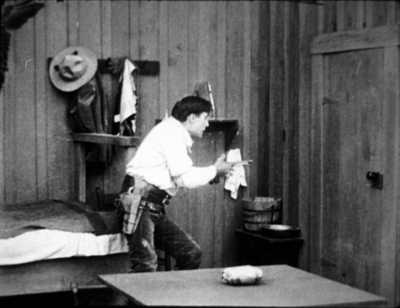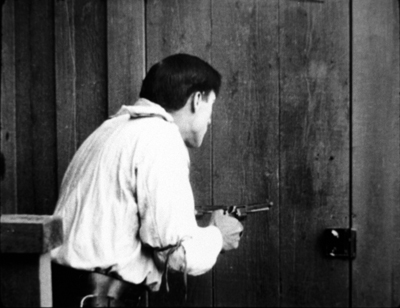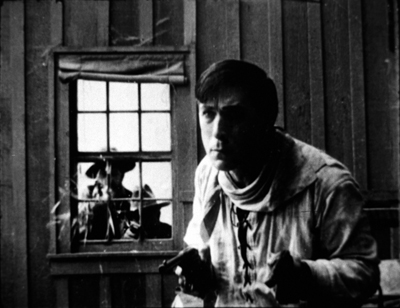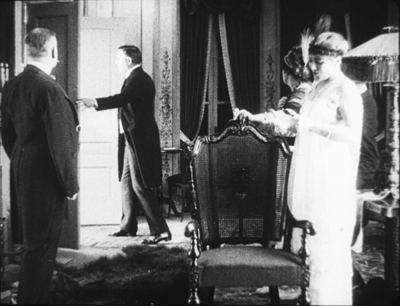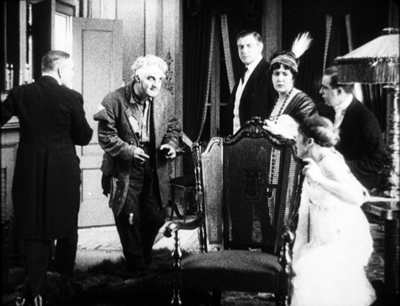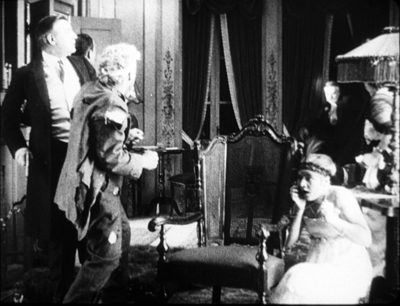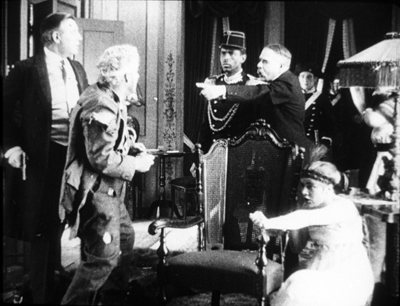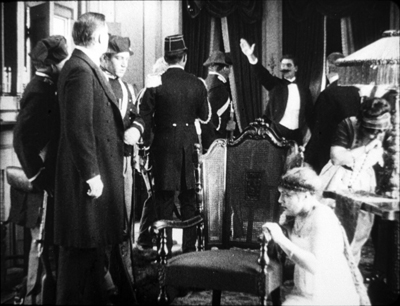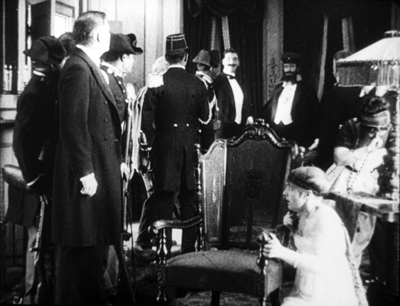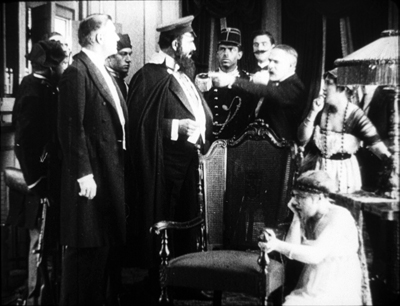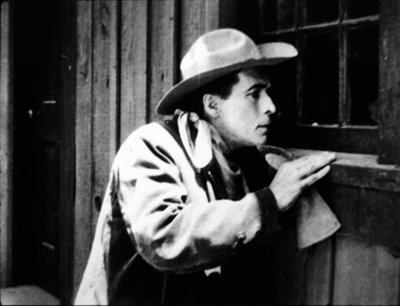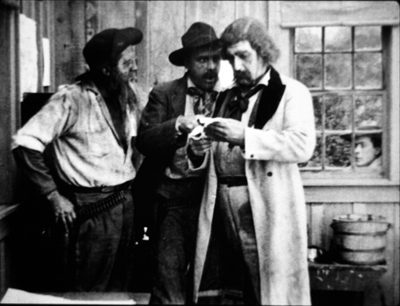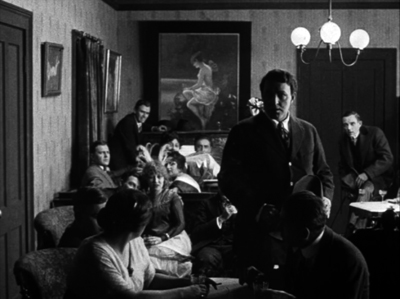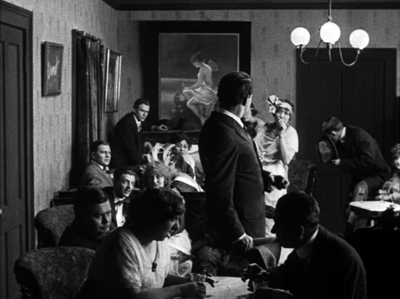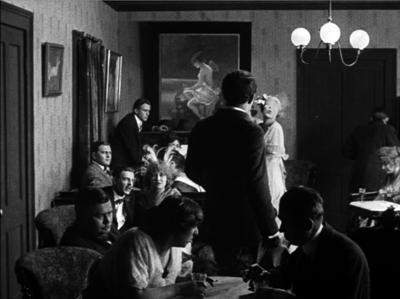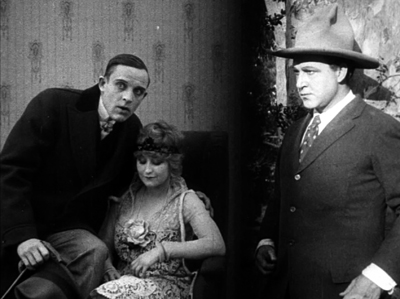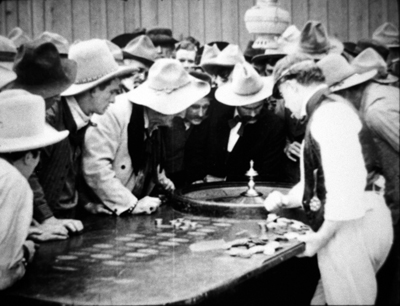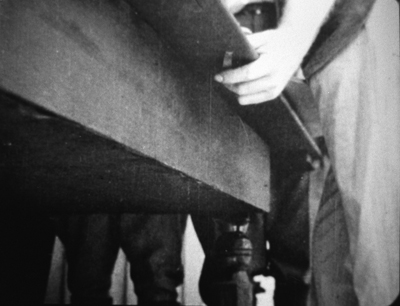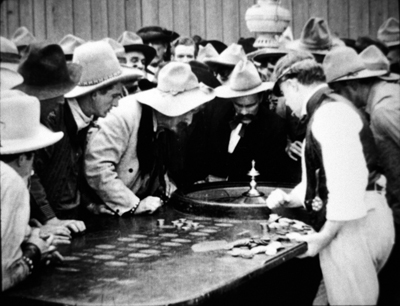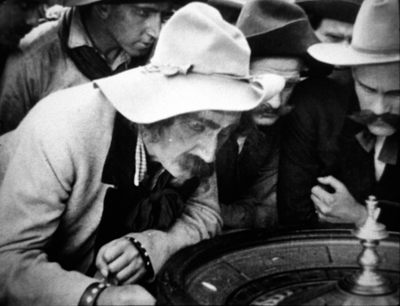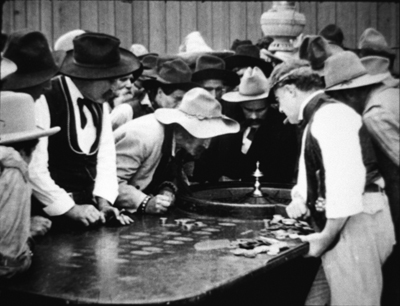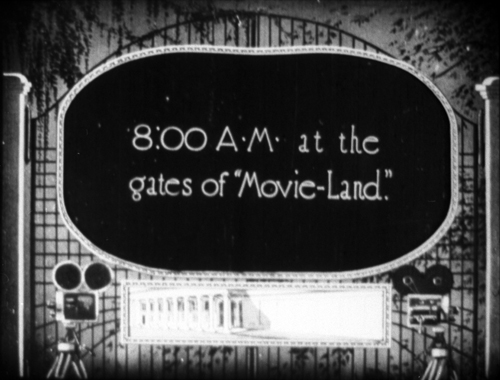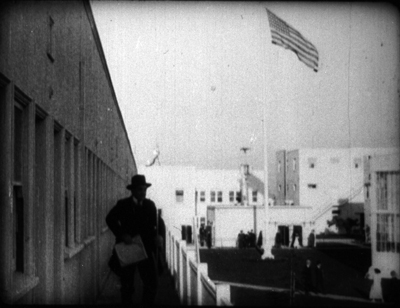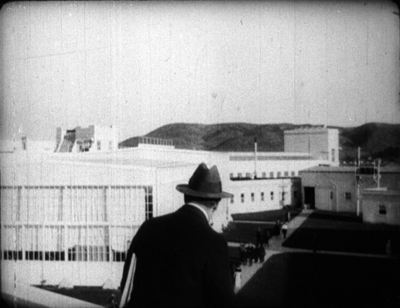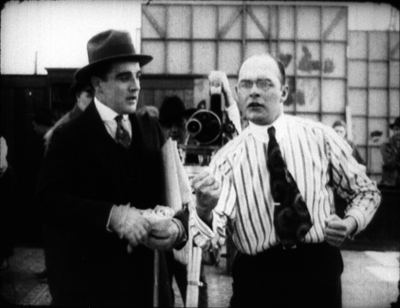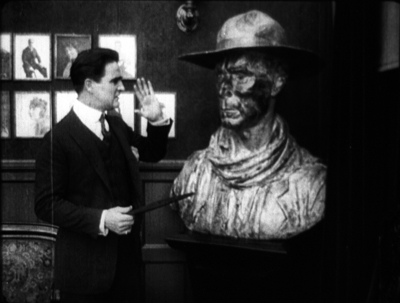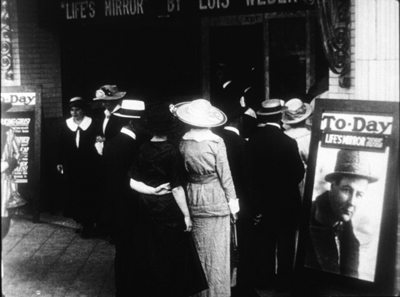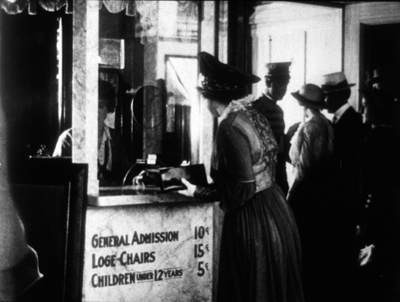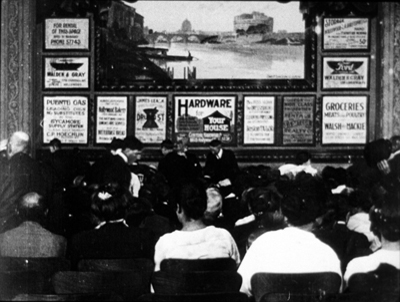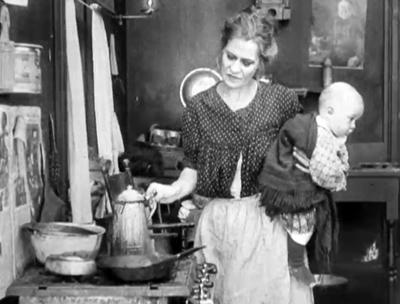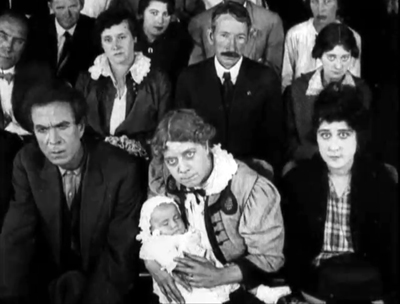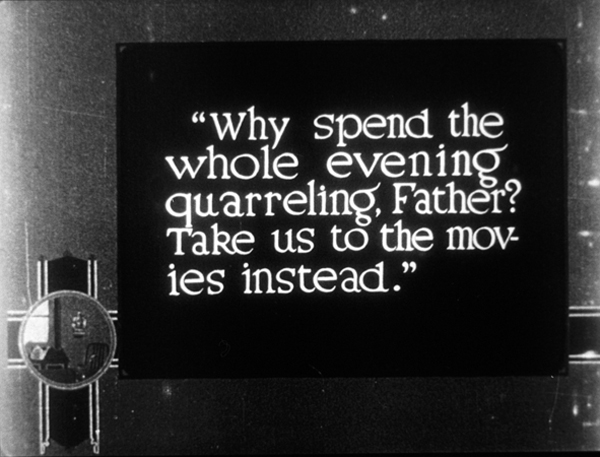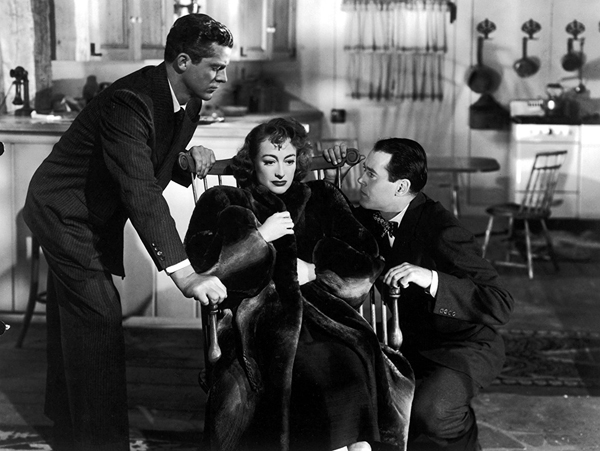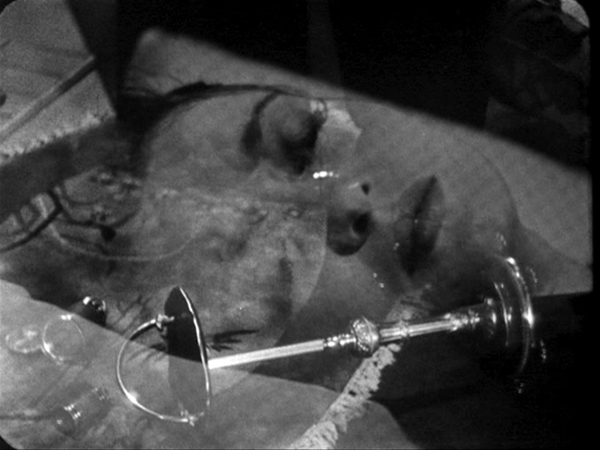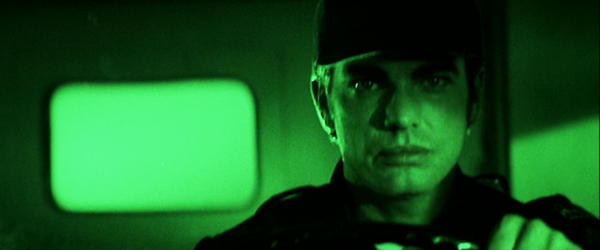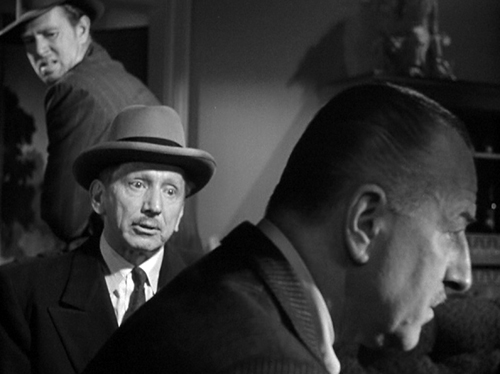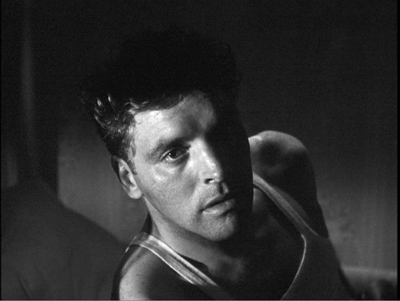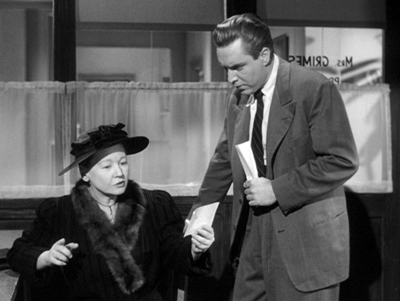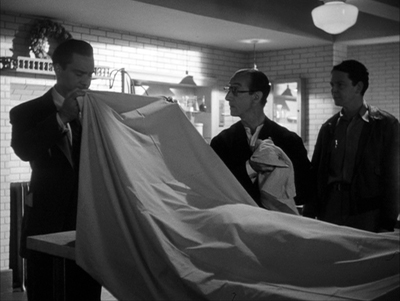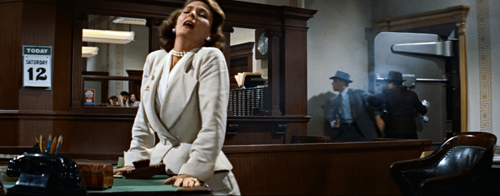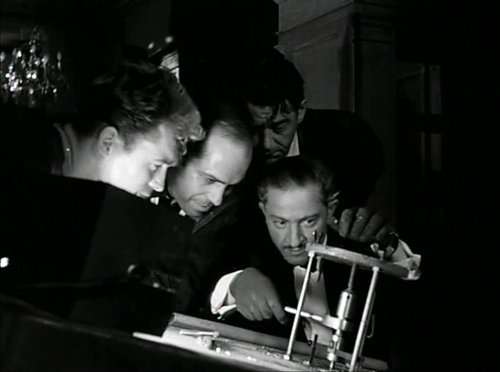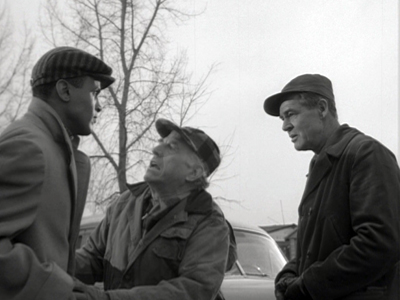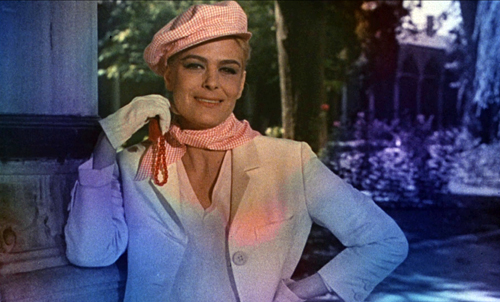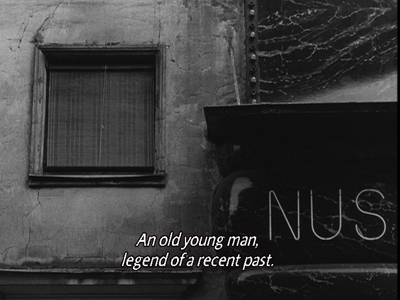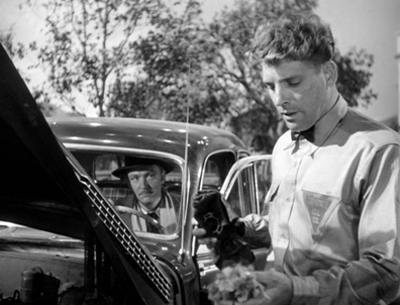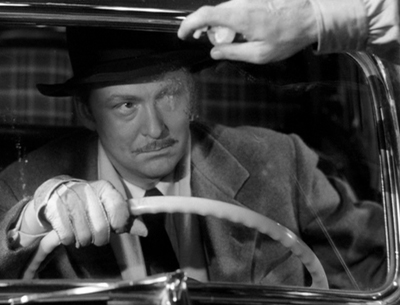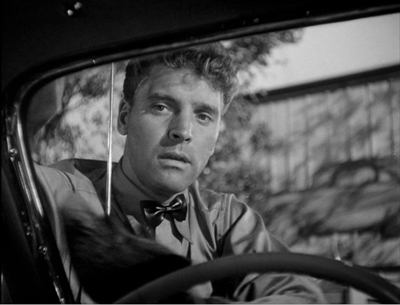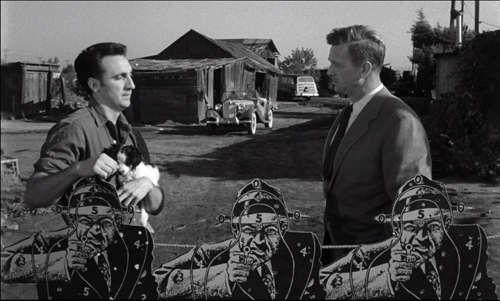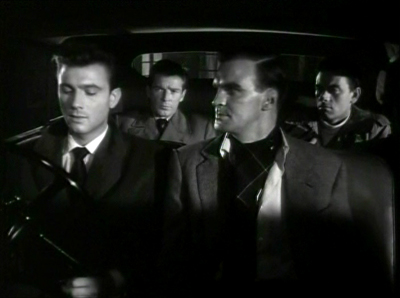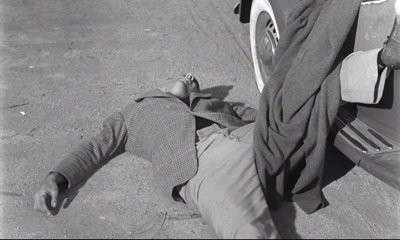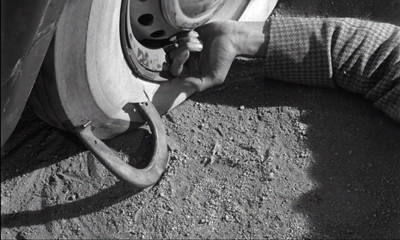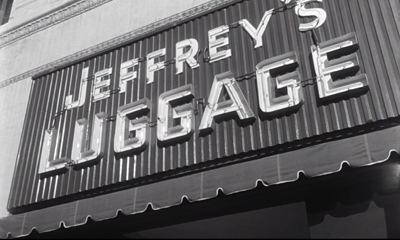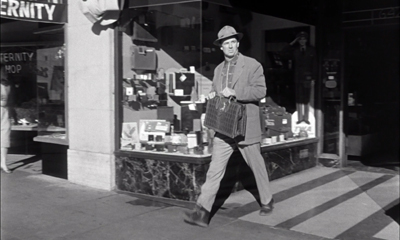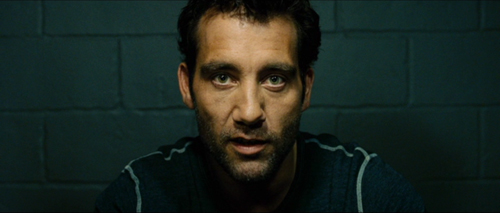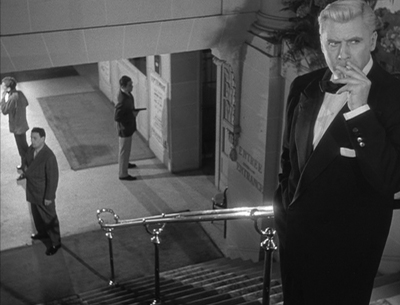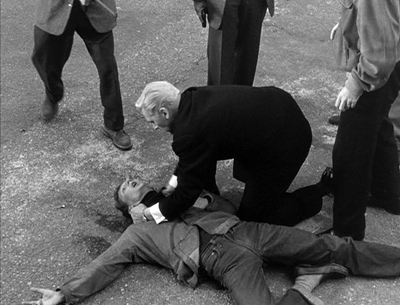Archive for the 'Hollywood: Artistic traditions' Category
The Boy’s life: Harold Lloyd’s GIRL SHY on the Criterion Channel
DB here:
On 9 September 1917, film history changed for the better. That was when we got the eyeglasses.
Their circular, horn-rimmed frames stood out as wire rims would not; besides, horn rims had become fashionable for young people. These specs held no lenses, but so much the better. Reflections from studio lights would have hidden the eyes of the winsome, earnest, clueless young man usually called the Boy.
In Over the Fence, the film introducing him, he’s already amiable, a little vacuous but delighted to be talking to his girl on the phone and watching himself doing it.
Harold Lloyd had already featured in some sixty-five short comedies from 1915, playing characters called Willie Work and Lonesome Luke. Even after introducing the Boy, Lloyd continued with a few Lukes before phasing out this sad sack. No one expected that in a few years the glasses character would become world famous. Lloyd’s films were more lucrative in aggregate than those of any other silent comedian, and he became one of the central figures in Hollywood.
When our comrades at Criterion announced their plan for a centenary Lloyd celebration this month on FilmStruck, I suggested we devote an installment of our series to one of the films. Kristin and I have been Lloyd fans for decades. Fans and collectors kept his work alive. Kevin Brownlow had to remind people with his Lloyd documentary, The Third Genius (1989), that, well, Lloyd was a genius. The more you get to know his work, the better it looks, and the less plausible seem many of the clichés that have clustered around it.
One of the very best films to get to know is Girl Shy (1924). That’s the one analyzed in the latest Observations on Film Art episode on the Criterion Channel.
Man into Boy
For decades after sound came in, American silent comedies dropped mostly out of sight. Some 16mm copies were available in cut-down rental versions, and a few were circulated by the Museum of Modern Art Film Library. (Of Lloyd’s work, that included only The Freshman of 1925.) The MoMA canon became the canon. In the 1970s, thanks largely to piracy, the films of Keaton were added, and still later we came to recognize Charley Chase, Max Davidson, and other talents.
Throughout these years Lloyd’s films were almost invisible because he controlled the rights to them and limited their circulation. Kept in vaults in his rococo estate Greenacres, they would not reemerge until the 1960s, in cut TV versions distributed by Time-Life. Until fairly recently, most critics relied on memory of the films and the received image of the Boy dangling helplessly from the clock face.
Most of the sixty-one shorts featuring the Boy languish in archives, and some were lost in a fire on the Lloyd estate. But several two-reelers are readily available, as are all the longer films. What we have gives the lie to most clichés about this filmmaker.
Take the most persistent one. Socially conscious critics of the 1930s saw Lloyd’s work as naively reflecting the go-go 1920s. The Boy’s resolutely middle-class aspirations made him a crass avatar of complacency before the Crash. Chaplin seemed to stick up for the little guy, but Lloyd seemed to celebrate the striver; he compared himself to Tom Sawyer. It was all very neat. The Boy’s climb up the skyscraper in Safety Last could symbolize the heedless ambition of the white-collar worker, while the his efforts to fit in at college in The Freshman suggest desperate American conformity.
Those interpretations played down the fact that just as often Lloyd played hayseeds humiliated by city folk and con artists. In Girl Shy, the city slicker who wants the girl is a weasel, and Harold has to rescue her. Here, as often, the film is largely a procession of social humiliations. Lloyd, a predecessor of cringe comedy, in turn provided a model of embarrassment for Ozu’s silent films. Those films often feature students wearing the Boy’s glasses (below, Days of Youth, 1929). This isn’t mere imitation or homage; the glasses became a Japanese fashion item, called roydo, named after Lloyd. (Below, a photo from a student ski trip in the 1930s.)
More edgily, Lloyd also played foppish idlers, louche one-percenters who glide obliviously through the lower orders and need to learn humility. The original title of For Heaven’s Sake (1926) was to be The Man with a Mansion and the Miss with a Mission, a phrase retained in an intertitle. Here as elsewhere, the coddled Boy learns to help his social inferiors. If you’re after class-based critique, Lloyd films come out pretty well.
Likewise, there were the complaints that Lloyd’s comedy was mechanical. Chaplin was the poet and dancer. Keaton, in both concept and execution, showed himself a geometer, the dogged engineer of monumental effects more awe-inspiring than hilarious. Though granting that Lloyd, foot for foot, yielded more laughs than any of his peers, critics worried that he was only merely funny, a relentless gag machine. Here is James Agee, in one of the subtlest appreciations of silent cinema ever written:
If great comedy must involve something beyond laughter, Lloyd was not a great comedian.
But immediately, as an honest man, Agee must add:
If plain laughter is any criterion—and it is a healthy counterbalance to the other—few people have equaled him, and nobody has ever beaten him.
Still, Agee admits that Lloyd’s films pass beyond laughter in one respect. They offer harrowing suspense. What his audiences called “thrill comedy” remains chilling today. His antics on skyscraper ledges and girders still induce vertigo, and his car chases risk catastrophe on a scale that would worry Jackie Chan. Agee seems to grant that inducing shrieks as well as guffaws is no small accomplishment.
If Agee could have reviewed all the feature films, though, maybe his judgment wouldn’t have been so absolute. For example, Lloyd’s features take us beyond laughter in serious ways—into regions of vulnerability and inadequacy. The Boy is typically given a fault: cowardice (Grandma’s Boy), self-absorption (as hypochondria in Why Worry? and as self-indulgence in For Heaven’s Sake), lack of confidence (The Kid Brother), neurotic extroversion (The Freshman). In several films, the seriousness undercuts the comedy.
In Grandma’s Boy, Harold can’t drive away the tramp, but Granny can do it easily, with some swipes of her broom. Our laughter is cut short when, in the space of a cut, as she calmly returns to the porch, we see the Boy slumped over, his head in his hands.
Soon he will admit that he’s a coward. Lloyd films switch their tone on a dime, shifting between comedy and drama breathlessly. In Girl Shy, the Boy not only dumps the girl he loves but does so by cruelly laughing at her trust in him. (Agee: “He had an expertly expressive body and even more expressive teeth.”) Wobbling and shifting his weight, Harold breaks the laugh with a gulp before carrying on his bluff.
Nothing in Keaton or Chaplin makes us as ashamed of our hero as we are right now. Soon he will do something worse.
This passage reminds us that Lloyd worked his face for all it was worth. Keaton had more expressions than he’s usually credited with (bewilderment, concentration, doggedness); it’s just that he doesn’t smile. Chaplin inherited the white-face clown tradition and often favored deadpan. He limited his facial reactions to squiggles and flashes, often no more than a skew of the mouth or hauteur in the brows, with an occasional embarrassed giggle. With Chaplin, the body expresses nearly everything, as befits an aesthetic predicated on the long shot.
But Lloyd, relying on medium shots, performs as a dramatic actor, with a wide repertory of expressions. Agee refers to his “thesaurus of smiles,” but he had other resources, as this Girl Shy scene attests. His producer Hal Roach is said to have remarked: “Harold Lloyd was not a comedian. But he was the finest actor to play a comedian that I ever saw.”
Another nuance: Comic laughter comes in many varieties. Like Keaton, Lloyd celebrates winning through tenacity and resilience. If we gasp at the geometrical audacity of Keaton’s humor, we’re buoyed by Harold’s righteous settling of accounts. It’s reported that audiences actually leaped up and cheered at the climaxes, when bullies and rascals were punished at delectable length. These are comedies of comeuppance and payback, outcomes universally enjoyed and still much in demand today, when millions hope for a scourging of the jackals in our White House.
Point the last: Neatness of construction. Chaplin’s films are lovably episodic; I still marvel that films that took so long to make are so loosely put together. Keaton by contrast is a metronome-and-protractor director, aiming to make every shot and sequence and reel sit in meticulous order. No one but he could have conceived the marvel of symmetry that is The General, or, on a lesser scale, Our Hospitality and Neighbors.
Lloyd’s films are no less finely put together, as many recognized at the time. A Film Daily review of The Kid Brother (1927) noted: “Lloyd and his gag-men again have devised a corking set of comedy situations that fit consistently into a well-joined plot and laughs keep building from little chuckles to hilarious roars.” Orson Welles praised “the construction of Safety Last, for instance. As a piece of comic architecture, it’s impeccable. Feydeau never topped it for sheer construction.”
To get a little more specific, I think that Lloyd’s model was the well-made dramatic film, the tight classical plot. This is the argument I make in the Girl Shy installment. I try to show that in this, his first film as an independent producer, Lloyd applied the emerging model of Hollywood narrative to feature-length physical comedy. Fairbanks had moved in this direction, and Lubitsch would achieve something similar with social comedy in The Marriage Circle (1924) and the masterpiece that is Lady Windermere’s Fan (1925).
Lloyd was a pioneer in showing how everything that worked for serious dramaturgy could work for comedy too. Girl Shy gives us a goal-oriented protagonist who has a serious flaw. Going beyond the figures of slapstick, we get access to his psychological yearnings and frustrations. His loneliness and fear of women fuel overwrought fantasies of domination. The Boy is caught up in the characteristic Hollywood double plot, involving love and career—two lines of action that usually block and deflect one another.
This linear action is deepened by a series of motifs. They’re simple in themselves (a stammer, a Cracker Jack box, a dog biscuit box), but they’re worked out with a pictorial and dramatic intricacy that’s rare at the time. And it’s all topped off by a two-reel chase that is simply one of the greatest ever put on the screen. At a time when every superhero blockbuster ends with a big action sequence, it’s worth seeing one that’s both graceful and hilarious, and it owes nothing to special effects.
Girl Shy shows how rewardingly complex silent Hollywood storytelling could be. It reveals Lloyd as a master craftsman of cinematic resources—dramatic, pictorial, emotional. He saw how to make a movie that would be engrossing even without the gags. The comedy deepens a powerful dramatic premise that moves forward with an organic, not mechanical, energy, and it’s developed in funny or poignant detail at every instant.
Filling the format
In the arts, form often follows format. The fourteen-line sonnet, the tondo painting, the twenty-two-minute sitcom, the nine-panel comic-book page: all provide the artist with a set framework within which to create. When Lloyd started out, film reels in the US were standardized at 1000 feet, which typically ran between twelve and fifteen minutes, depending on projection speed. Short films, particularly comedies, were either one or two reels, while features–dramas, mostly–ran four, five, or more.
The task of the filmmaker was to build a story that would fit the format. The temptation was padding. Griffith, for instance, often filled out his shorts with “goings and comings,” shots of characters leaving one place and making their way to another, sometimes across several shots. But once padding was inserted, filmmakers could make it engaging. Griffith did this by embedding the goings and comings in suspenseful situations, so that the travel shots served as dramatic delays. Mack Sennett needed scenes to lead up to a big chase (the “rally”), but those scenes could themselves have a linear logic, as with romantic rivalry or street quarrels.
Lloyd became very sensitive to film length. He knew that his initial popularity depended on the fact that Pathé and producer Hal Roach spit out a Lonesome Luke every week or two; he saturated the market. Even after Luke appeared in two-reelers, Lloyd wanted his new character, the Boy, to start in one-reelers. He recalled telling Roach, in sentences as breathless as the pace of a one-reeler:
Now, I’m getting started in a new character and you want people to get used to the character, you want them to see the character; and besides, if you make a poor, or mediocre, or moderately good, or even a bad picture in a two-reeler, it’ll kind of tend to sour the people on you because they won’t see another one for a month. But if I make one-reelers, we’ll get one out every week, so if a couple of them are not so good, and the third one is, it will cover up the other two, and besides it will keep you in front of the public.
As a result, Lloyd spent two years turning out an astonishing eighty-two one-reelers. Not until Bumping into Broadway (2 November 1919) did he launch a two-reeler featuring the Boy.
There’s evidence that Lloyd’s awareness of the niceties of running times went beyond a concern for building the brand. He understood that form and format had to mesh. His early one-reelers relied largely on the standard episodic knockabout. We’re given a defined situation, such as a modernized hotel (The City Slicker, 1918), a western saloon (Two-Gun Gussie, 1918), or a vaudeville theatre (Ring Up the Curtain, 1919). In this situation, the characters quarrel, pull pranks on one another, engage in fistfights, kick each other in the pants, and usually wind up in a chase. A string of gags might emerge, as when a stray snake terrifies the theatre troupe in Ring Up the Curtain, but the gag is quickly exhausted, and we go on to the next bit.
Once Lloyd settled on two-reelers, he built them up more carefully. He scaled, we might say, his plots and gags to a fairly tight, logical development in the fuller format. Part of that development involves what we might call nested gags. In Captain Kidd’s Kids (1920), the first part (roughly one reel) sets up Harold as a playboy recovering from a bachelor party. In his elaborate bathroom, he tips back his chair, leading us to expect him to fall in. But no: instead his butler, Snub Pollard, dumps ice in the pool.
There follows a string of shaving gags here and in the next room. Early in this series, Harold drips shaving cream in his morning tea; but after other gags he comes to drink it and finds it foul-tasting. Then he returns to the bathroom, tips back the chair again, with results we’d expected several minutes before.
Now we get some elaborate efforts to rescue Snub. The gags are simple, but by setting up one and then moving to set up and pay off others before returning to the first, Lloyd and his team avoid the start-stop-restart pattern than we find in many one-reelers.
The real plot action, of course, doesn’t get going until the second reel of Captain Kidd’s Kids, but Lloyd has provided some lively padding to start. Now or Never (1921) shows the same gag-braiding, with the recurring appearance of two drunks on the train ride that constitutes the bulk of the film.
Lloyd moved toward longer films cautiously—first to three reels, then four (A Sailor-Made Man, 1921), then five (Grandma’s Boy and Dr. Jack, 1922). He always said that most grew organically, beginning as two-reelers and then expanding when the story premises and gag sequences developed. To keep things in proportion, he tested the results on preview audiences, then reshot and recut his footage. The preview responses to one three-reeler, I Do (1921), convinced him to lop off the entire first reel. Although he had increased confidence in his ability to scale up, when he signed a new contract with Pathé in early 1922 he insisted that the company publish a notice to exhibitors declaring that film length would be
strictly governed by the character and quality of the material evolved in the production development of each subject—which means that the Lloyd standard of excellence is to be maintained first of all; a given story that turns out to be adequately filmed in two reels will be confined to two reels, and so released. This is a principle cherished by Lloyd himself.
Lloyd could be so confident because even his shorter releases were becoming the top-billed item on programs across the country. He was, in effect, returning the idea of “feature” to its original meaning—not simply a long film, but rather a movie that could be “featured” in publicity. He was also announcing his unusual concern for tight form.
Comic architecture
Grandma’s Boy (1922).
Lloyd moved to features in synchronization with his peers. Keaton was the first, with The Saphead (September 1920), though it’s less a comedy than a light drama; and Keaton returned to making two-reelers for three years. The Round-Up (October 1920) gave Fatty Arbuckle a comic role in what was basically a serious drama. Arbuckle starred in The Life of the Party (December 1920), another light drama with almost no physical comedy. Chaplin’s The Kid (February 1921), at a bit more than five reels, might be considered the first slapstick feature since the one-off Tillie’s Punctured Romance (1914, six reels). The émigré Max Linder got into the act with two 1921 features, Seven Years’ Bad Luck (May 1921) and Be My Wife (December).
It might seem that Lloyd was a bit late with the four-reel Sailor-Made Man (December 1921). But that film capped his most extraordinary year to date, with four earlier films released in spring, summer, and fall. Along with six two-reelers released in 1920, Lloyd was now a major comedy star, and the Boy could carry a longer story.
But how to do that? His peers explored some options. In Arbuckle’s two features, it’s his physical presence that matters, not consistency of character; in one he’s a genial sheriff, in the other a lawyer inclined toward crookedness. Chaplin retained the Tramp persona in The Kid, but the film is a rather episodic affair. Once the main plot is resolved, a reel pads out its length with a dream sequence set in heaven. The Linder films are lively but digressive, with plots propelled by casual pranks and lovers’ misunderstandings.
By contrast, Lloyd’s features moved toward tight construction. Despite his claim that his films just grew longer accidentally, they were shaped in ways that make them seem through-composed. His comedy sequences are deftly prolonged, building and topping themselves with great speed. Gags are embedded and interwoven in ways that yield surprises, and motifs set up early in the film pay off later. We may have forgotten about them, but Lloyd hasn’t.
Lloyd’s obsession with overall form can be seen in his use of the “Lafograf,” a kind of EKG of viewers’ response at previews. Coders sat in the audience with pencil, paper, and stop watches to note every bit of amusement, from a titter to a screech. Once graphed, the entire movie displayed laughs big and small throughout, with most of the big ones spiking in the last reel.
A powerful demonstration of Lloyd’s skill came in his first five-reeler, Grandma’s Boy (1922). Chaplin called it “one of the best constructed screenplays I have ever seen on the screen.” Lloyd began it as a two-reeler, but after expansion it had become more drama than comedy. Roach urged him to add more gags, and the result is a remarkable balance between humor and pathos.
That mixture is given from the start in a prologue showing a baby Harold, glasses and all, bullied by another baby. Then the Boy as a boy is picked on and made to put a chip on his shoulder.
This last bit will pay off fifty minutes later. The rival, the little bully grown up, taunts Harold, not knowing Harold has captured the prowling tramp and proven his courage.
The upshot is a fight that knocks the stuffing out of the Bully. In the course of that fight, another moment calls up a contrast with an earlier scene. The day before, the Bully has pitched Harold into the well; now, after the Rival tries a foul blow, Harold administers payback.
These distant echoes can be very satisfying.
The organization of gags is likewise remarkably sustained. Walking home from his well dunking, Harold finds that his one suit has shrunk grotesquely. But the Girl has invited Harold to her home for an evening, so he needs another suit. Granny digs out his Grandpa’s suit, 1862 vintage. (The peddler said it was unique.) It still has mothballs in it. Granny also finds there’s no shoe polish, so she uses goose grease instead. These bits become the basis of a steadily building gag situation in the Girl’s parlor.
But not right away. First Harold arrives and discovers that his vintage outfit is matched by that of the butler. Another echo, when he mutters: “That peddler lied to Granny!” He sits to listen to the Girl play the piano, and gets his finger caught in a vase. Only now does one of the earlier gag setups start to pay off. A cat comes to lick his tastily greased shoes.
The grown-up Bully was introduced throwing a stick at a cat, but Harold is more gentle. He nudges the Girl’s cat away, but soon a troupe of cats enters to converge at his feet.
He has to dispose of them without the Girl’s noticing. Finally, when the couple move to the settee, the cats reconnoiter and the gag sequence pays off: Harold uses a statuette of a bulldog to scare them away.
Cozying up to the Girl, Harold ought to be in clover, but now she smells something—his suit. Investigating, he finds mothballs that he and Granny failed to remove. I’ll spare you more description. You can watch what happens next, including a new confrontation with the Rival. And again, Harold gives us an unforgettable suite of facial expressions.
Lloyd’s pacing allows just enough time for us to anticipate what might happen at each turn of events. Structurally, while Lloyd is developing and paying off the IOU of the mothballs, he wedges in a fresh setup, that of the neighbor kid’s requesting some gasoline. That becomes the topper for the mothball series, as the dog statuette topped the cat gags. This sort of braiding of gags, weaving the setup of one gag into the development of another, shows how a feature can be built out of quasi-melodic lines, like a song.
Even more important is the presentation of the protagonist. Lloyd gives his hero what modern screenwriters call a character arc. In the early 1920s Lloyd began to distinguish between gag pictures and “character pictures,” in which the story line depends on our concern for the protagonist.
In his short films, Harold had an established image, but his characterization varied a lot. Sometimes he was a good-natured everyman, but he could also be a scrapper, a hustler, or a ne’er-do-well. And his romantic relations with Bebe Daniels were wonderfully flirtatious; in one she helps him count bills by licking his thumb. In the features, Harold was given a more definite character, one with a pronounced fault. He was often insecure, awkward, and oblivious, qualities that led critics to call him a boob. The insult is referenced in Girl Shy, when his book gets mocked as The Boob’s Diary. Correspondingly, the romance plotline of his films became much more fraught.
In Grandma’s Boy, Harold’s fault is cowardice, and he must keep the Girl from finding it out. His impulse is to hide from the world, but Granny inspires him with the tale of how his Grandpa overcame his fears and helped the southern army win the war. He did it, she says, thanks to a Zuñi charm given him by an old woman.
Now Grandma gives Harold the charm, and his faith in it enables him to capture the murderous thief. In a double climax, Harold, still clinging to the charm, is able to beat the Bully in a drag-out fistfight.
Of course the action is packed with delays, detours, and surprises. The capture of the thief is a superb flow of gags, from Harold braving the tramp’s hideout to a long chase, in which the talisman does duty as a pistol barrel. And the fight with the Bully gets expanded when Harold loses the charm and turns suddenly meek. After the fight, the topper comes when Granny reveals the real source of the charm’s power. Harold comes to understand that he has inherent reserves of courage.
Nicholas Kazan once observed: “You want every character to learn something. . . . Hollywood is sustained on the illusion that human beings are capable of change.” This principle of construction goes very far back, and it became the basis of Lloyd’s feature plots. We get not just a change of fortune (and so a happy ending) but a change in personality (and so a happier one).
From Grandma’s Boy onward, Lloyd’s features display disciplined, inventive construction–at the macro-level of plot and at the mid-range of gag sequences, down to precise shot-by-shot articulation of the action. Here’s a moment when Grandpa (he wears glasses too) sees, reflected in an inkstand lid, a Union officer preparing to clobber him.
Since the Bully is reincarnated in the Union officer Harold outwits, this flashback quietly prefigures the Boy’s victory over the Bully at the climax.
In my Criterion Channel presentation, Girl Shy serves as another example of how Lloyd brought classical construction to comedy. I could as easily have picked another superb item, The Kid Brother. Maybe next year?
It seems likely that Lloyd’s work became a model. Keaton’s trimly carpentered second feature Our Hospitality (1923) is in the same vein. And Chaplin, after he praised Grandma’s Boy, went on to declare: “The boy has a fine understanding of light and shape, and that picture has given me a real artistic thrill and stimulated me to go ahead.” Lloyd and the Boy, glasses and all, remade Hollywood comedy in important ways, and in the process they gave us wonderfully exuberant films.
Thanks as usual to Kim Hendrickson, Peter Becker, Grant Delin, and their team at Criterion. Thanks as well to Jared Case of George Eastman House for information about their print of Never Weaken.
Lloyd’s autobiography, An American Comedy, was timed to the 1928 release of Speedy, and it’s full of detail about gag structure and the production of his films. At one point he transfers our old friend, the distinction between suspense and surprise, to comedy. The book includes Frances Marion’s memorable line, “Harold, you’ve got to lose your pants.” Coauthored by Wesley Stout, An American Comedy was reprinted in a sturdy Dover edition with a 1966 interview and a cliché-challenging introduction by Richard Griffith.
Lloyd has been lucky in his admirers. Richard Schickel’s Harold Lloyd: The Shape of Laughter (New York Graphic Society, 1974) yields a finely sustained appreciation of his art. Adam Reilly’s Harold Lloyd: The King of Daredevil Comedy (Collier, 1977) is a vast compendium of biography, plot synopses, and visual documentation. Tom Dardis’s Harold Lloyd: The Man on the Clock (Viking, 1973) is a careful biography that situates Lloyd’s career in the development of the film industry. Donald W. McCaffrey offers a comparative study of plot structure in Three Classic Silent Screen Comedies Starring Harold Lloyd (Associated University Presses, 1976).
Most comprehensive of all is the remarkable Harold Lloyd Encyclopedia (McFarland, 2004) by Annette d’Agostino Lloyd (no relation). All the films are synopsized with credits and items from trade papers. Her Harold Lloyd: Magic in a Pair of Horn-Rimmed Glasses (BearManor, 2009) is full of fan enthusiasm, shrewd observation, and information I couldn’t find elsewhere. (She even checked Lloyd’s FBI file.) My Welles quotation above comes from this book, p. 167, as does Harold’s explanation of starting the Boy in one-reelers (pp. 85-86). The indefatigable d’Agostino Lloyd earlier produced Harold Lloyd: A Bio-Bibliography (Greenwood, 1994).
The Agee essay is of course “Comedy’s Greatest Era” from 1949. My quotations come from James Agee, Complete Film Criticism: Reviews, Essays, and Manuscripts, ed. Charles Maland, vol. 5 in The Works of James Agee (University of Tennessee Press, 2017), p. 883. My Chaplin quote comes from Dardis’s biography, page 112. The quotation from Nicholas Kazan is in Jurgen Wolff and Kerry Cox, Top Secrets: Screenwriting (Lone Eagle, 1993), 134. Lloyd’s movie-measuring scheme is explained in P. A. Thomajin, “The Lafograf,” American Cinematographer (April 1928), 36-38, as applied to The Kid Brother, online here. The graph for Speedy is reproduced in Reilly’s Harold Lloyd, pp. 106-107.
A very pretty collection of early Lloyds is on Vimeo from Random Media. The standard DVD assemblage of features and shorts is the multiple-disc Harold Lloyd Comedy Collection. Several of these films are streaming on the Criterion Channel. Unfortunately, the version of Never Weaken (1921) available in these collections is a 1925 re-edit of the original three-reeler. The full version survives, however, and is available, in a so-so video, here. Criterion also offers an excellent Blu-ray disc of Speedy (1928), with solid extras, including an essay by Phillip Lopate and a visual essay on the film’s New York locations by Bruce Goldstein.
I analyze Ozu’s strong debt to Lloyd in Ozu and the Poetics of Cinema, pp. 152-159.
For the trivia fanatics: I think Harold’s manuscript in Girl Shy is mocking a sensational movie of a few years before, Men Who Have Made Love to Me. This film, written by Mary MacLane, an early feminist and scandal-rouser, was based on her memoirs. The movie is laid out in six parts, each devoted to the seduction method employed by one of her suitors. The film is lost, but it seems likely to have been the target of ridicule in the Lloyd picture.
Girl Shy (1924).
Something familiar, something peculiar, something for everyone: The 1910s tonight
Idle Wives (1916), produced by Lois Weber and Phillips Smalley.
DB here:
This year I’ve been bouncing between two magnificently creative decades in US film, the 1910s and the 1940s. In autumn I’ve been caught up in things involving Reinventing Hollywood, but those were followed by some big doings on campus.
In spring I was lucky enough to be in residence at the John W. Kluge Center at the Library of Congress. That enabled me to watch nearly a hundred feature films from 1914-1918. I did a talk at the Library reporting on some of that work, and I’ve offered some preliminary observations on those in earlier entries.
Last week, Jim Healy of our UW Cinematheque brought some of the films that had impressed me during my DC stay. There was a Saturday marathon of The Iced Bullet (1917), Alias Jimmy Valentine (1915), The Bargain (1914), Will Power (1913), and The Man from Home (1914). For our Film Studies Colloquium across two Thursdays we screened False Colours (1914; incomplete), The Case of Becky (1915), Idle Wives (1916; incomplete), and Ben Blair (1916). Some of these I’ve written about in earlier entries, here flagged by links.
The Saturday screenings were accompanied by the lively, indefatigable playing of David Drazin. David worked for many hours and without having seen the films in advance. He’s a superb artist.
Seeing the films again, of course I found more to say.
Revival and revision
The Case of Becky (1915).
One of the secondary arguments in Reinventing Hollywood is that many storytelling techniques of silent film subsided during the 1930s but were revived during the 1940s. Silent films were full of dream sequences, subjective points of view, fantasy projections, and flashbacks. Those got elaborated and consolidated for the sound cinema by Forties filmmakers.
So it wasn’t surprising to find that The Bargain, a fine William S. Hart western, squeezed a lot of mental imagery into a single scene. The Sheriff has arrested Jim Stokes and retrieved the money he stole. Lashed to the bedpost, Jim remembers his wedding and the woman he’s betrayed, presented in a slow dissolve to the past.
Meanwhile, downstairs in the saloon casino, the Sheriff succumbs to an impulse and loses all his money at roulette. Then he remembers, via another dissolved-in flashback, that he scooped up the stolen money too.
Back in the present, he digs that money out of his poke and bets it—and loses.
Later, in the hotel room, Stokes learns of the Sheriff’s folly and has a good laugh. But then he imagines Nell waiting for him, shown in a split-screen image.
At which point the Sheriff imagines his telegram arriving at his town, announcing Jim’s capture and the recovery of the money. That vision reminds him that he can’t return without the money he has squandered.
This makes him strike the central bargain with the thief he’s captured.
In a 1930s film, these visualized memories would most likely be presented verbally, as part of the stream of dialogue. (“When I think of marrying Nell….””I’ve promised to bring the money back…”). But 1910s American films tended to use dialogue titles sparingly; a lot of the films we saw asked the viewer to grasp the situation without benefit of words. The Bargain has only nineteen dialogue titles in 77 minutes (at 16 frames per second).
The Bargain is a good example of how purely pictorial storytelling was used to explicate a situation. Interestingly, today’s films are rather close to this tendency: fragmentary flashbacks and mental visions are common in mainstream movies.
Another echo struck me, this time in The Case of Becky. This is an early story of split personality, a narrative premise popularized after The Strange Case of Dr. Jekyll and Mr. Hyde (1886). Here the young woman Dorothy (Blanche Sweet), under the sway of the sinister hypnotist Balzamo, develops a second identity, the surly and disruptive Becky. Becky isn’t really very dangerous, but when a young doctor, himself a master of hypnosis, falls in love with Dorothy, he determines to cast out Becky. He does so in a passage of intense mind control, visualized through a double exposure of Becky departing Dorothy’s body.
What interested me is that the same visual device was used by Arch Oboler in Bewitched (1945), one of the earliest psychoanalytical films of that era. The heroine’s two sides are summoned up by the shrink.
I suspect that Oboler got wind of the Selznick/Hitchcock Spellbound (1945) and rushed a B-film into production. (He could move fast because he adapted one of his radio plays.) Bewitched was released five months before the Selznick/Hitchcock film. It’s not great movie, but it has a sort of pre-Psycho pitilessness, and it’s always nifty to see a 40s film picking up on a silent-film device.
Cutting things up and filling the corners
My main research questions about the 1910s revolved around stylistics—matters of staging, lighting, shot scale, variety of camera setup, and editing choices. For about twenty years I’ve been exploring how, to put it broadly, the long-take, intricately staged tableau cinema was largely replaced by films dependent on continuity editing. By focusing on the years 1914-1918, I thought I could track the transition in finer grain.
Many films were already building their scenes out of several shots. Go back to The Bargain, from 1914. A series of shots shows Stokes surrounded at the door and window, while also giving us a brief shot from a new angle incorporating tight depth, as the men at the window get the drop on him.
This freedom of camera placement within a single set is typical of the Hart films (see here and here), and of other films by Reginald Barker. It was sometimes visible in Alias Jimmy Valentine from the year before (1913), but it’s more pronounced in The Bargain. Several scenes in the hotel room where Stokes is tied up display a fairly wide array of camera setups.
At the other extreme, The Man from Home (1914), credited to Cecil B. De Mille and Oscar Apfel, displays the tableau approach in full bloom. One long take at the climax shows a packed salon. To take just the high points of some pretty dense choreography: Ivanoff bursts in to confront his errant wife, who crumples in the lower right.
Pike holds off the Earl of Hawcastle, now partnered with Ivanoff’s wife. Hawcastle rushes to the right rear to open the curtains (stepping into a spotlight). Summoning the police, he returns to the middle ground to demand the arrest of the fugitive Ivanoff.
But a functionary arrives in the background, lifting his arm to signal the arrival of the bearded Grand Duke Vasili. Vasilii stalks in to take command of the middle ground and confront Hawcastle. Throughout. shrewd shifts of actors’ position open pockets of action, and the performers turn from the camera to drive our eye into depth.
Throughout most of this tableau, broken by occasional titles, Ivanoff’s treacherous wife is crouching in the lower right. This is an example of the “all-over staging” we find in 1910s cinema. Often corners and edges of the frame will be activated and demand to be noticed. For example, in The Bargain Stokes is observing a scene through a window. Cut inside the room, and Stokes can be seen way off to the right in a single pane.
Later directors would have placed the window nearer frame center so that Stokes’ face would be more quickly noticed.
Sometimes we find the filmmaker trusting the audience—or at least a modern audience—too much. In Ben Blair (1916), Ben is lured into a brothel and pulls his pistol in order to escape. But in the master shot, off to the right, the astute viewer can see the louche Sidwell, who’s aiming to marry Flo, cozying up to a hooker before he rises to flee the room. He has already met Ben and fears being recognized.
Director William Desmond Taylor doesn’t supply what I expect Barker would provide: a separate shot of Sidwell seeing Ben and rushing out of the room. Nor does Taylor provide a gradually unfolding tableau that would, by means of figure movement, frontality, centering, and other cues build to a crescendo revealing Sidwell’s presence—the sort of thing we see in The Man from Home. As it is, many viewers may miss the main point of the scene, which is to divulge Sidwell’s sexual betrayal of Flo.
But maybe this was best. Cutting straight in to Sidwell might have suggested that Ben recognizes him immediately. But he doesn’t. As Ben turns, Sidwell is ducking away. Ben has revealed, and seems to be concentrating, on a new center of interest, the woman who’s impudently blowing out cigarette smoke at him. He, like us, is distracted from Sidwell’s departure.
Still, we’re supposed to spot Sidwell even if Ben doesn’t. Only much later, after Sidwell has nearly convinced Ben to give up on courting Flo, does Ben realize that it was Sidwell he saw in the brothel. That’s done through a split-screen flashback of Sidwell starting guiltily beside his floozy.
Again, the shot is a little clumsy in showing Sidwell looking toward the camera, as if Ben saw him directly; but it seems to be another mental image, representing Ben’s now-clear impression that Sidwell was in the brothel.
We don’t have to puzzle over such matters in The Bargain. Barker had mastered the precision necessary for off-center details. When the Sheriff is risking his money at the roulette wheel, a close-up reveals that the croupier is controlling it.
But here’s the neat part. At the turning point, when the Sheriff loses everything, Barker gives us close-ups of the Sheriff and the croupier, but not the hand pressing the button.
We’re sufficiently trained to spot the croupier pressing the button in the long shot (again, off-center). There’s no need to show the gesture again because the priming close-up has told us the game is fixed. Interestingly, that insert shot doesn’t come at the very start of the Sheriff’s gambling jag, so initially we might think the wheel is honest. We get the revelation just when the Sheriff is about to bet the money he can’t afford to lose. That boosts the dramatic tension.
Movies within movies
The Iced Bullet (1917).
While stylistics was my prime research focus, I couldn’t help but notice some bold narrative initiatives. A good example of a playful one was The Iced Bullet (1917), which has a Russian-doll structure (like many 40s films).
The inner tale recounts how a scientific detective solves an attempted murder, one using the method tipped in the title. But that’s swallowed up in a prologue and epilogue showing a foppish author crashing the Ince studio. He manages to interfere with filming, evade the guards, and take refuge in an executive’s office. He has brought along his screenplay, The Iced Bullet, which he hopes to direct and star in.
At the desk he falls asleep and dreams the detective story we see. At the film’s end he wakes up and flees the studio, pursued by watchmen. One trade paper of the time suggests that the comic frame story was devised in order to expand and elevate the murder story–which may explain why the film has been credited to both Reginald Barker and Charles Swickard. Maybe one directed the frame story and one the embedded one.
As the frame story stands, it offers us not only a comic pretext but precious views of the vast Ince studio.
There are also some nerdish in-jokes. C. Gardner Sullivan, author of the whole film we see, appears as the executive whose office is commandeered, while Barker shows up as a raging director trying to get the aspiring screenwriter off the set.
And when that invader takes over Sullivan’s office, he scoffs at a huge bust of William S. Hart, by now a major star.
The year before, Lois Weber and her husband Phillips Smalley had given us a more intricate film-within-a-film structure. The central story of Idle Wives centers on the plights of three women. Anne Wall is a wealthy but disillusioned wife who leaves her husband John to take up settlement work. She lives with Alberta, who has married John’s brother Richard. The couple has been disowned by John’s mother and sister. In her charity duties Anne meets Molly Shane, who has left her family to run off with the no-good Larry. Anne helps Molly through her pregnancy and reconciles her with her family. John, seeing how Anne has changed the lives of unfortunate women, welcomes her back and faces down the disapproval of his mother and sister.
This story is enclosed within another one, involving three other women. The Jamiesons, though wealthy, have an empty marriage. When Jamison meets an old girlfriend, they decide to go see a movie. They’re trailed by Mrs. Jamieson. At the same time, Mary Wells disobeys her mother and goes out with the thug Tough Burns. They wind up going to the same movie theatre. And the poor, hard-working Smith family, whose daughter is longing to escape, decides to take a day off and go to the theatre as well. All of them join the audience for Life’s Mirror, a film by none other than….Lois Weber. It stars Weber and Philips Smalley, who’s given his own poster.
This frame story, not in the source novel, is pretty stunning. In the first reel the people assemble at the theatre, which, as you see up top, flaunts the Weber-Smalley brand. These scenes are fascinating representations of moviegoing culture of the time, showing the ticket booth and the auditorium.
Just as important is the way that seeing the movie affects the characters in the frame story. Shots show people in the audience reacting to the fictional world.
The point of the film is that the characters, recognizing their counterparts on the screen, improve their behavior. Cinema is granted the power to divine the problems of its audience, and to heal their lives.
Or so we’re told from contemporaneous synopses. Because, in one of the great losses of American silent cinema, we have only the first and second reels of Idle Wives. Fortunately, those constitute the prologue and the initial exposition of the inner story.
How does the frame story turn out? According to the fullest contemporary account I’ve seen, in the epilogue Jamieson sees his wife weeping in the aisle, sends her rival away, and reconciles with her. Mary is shocked into realizing the risk of dating Tough Burns, who seems ready to reform after seeing his fictional double behave so cruelly. The Smiths agree to be kinder to one another, and the daughter of the family realizes the danger of fleeing home.
Two network narratives, then, in a single movie. Idle Wives has over twenty individuated characters, linked by kinship or domestic circumstances. (For instance, in both stories some characters live in the same building.) It becomes didactic, as Weber’s films often are, with the theatre presenting a placard that underscores the lessons, and opening titles that address the audience directly. Idle Wives was fairly described by a review as “a preachment on the sacredness of the home, also on the power of the motion picture.”
For most film historians, the great experimental film of 1916 was Intolerance, another tale of parallel situations and fates. But the same month that Griffith’s ungainly masterpiece was released saw the appearance of Idle Wives—in its way, no less daring, and by today’s standards startlingly modern. How many other remarkable films have been lost or have gone unnoticed? Like archaeologists excavating a site, we have a lot more digging to do to understand the glories and unpredictable experimentation of the cinema of the 1910s.
Thanks to my hosts at the Kluge Center last spring: Ted Widmer, Emily Coccia, Travis Hensley, Callie Mosley, Mary Lou Reker, and Dan Turello, as well as the team in the Moving Image Research Center–Karen Fishman, Dorinda Hartmann, Josie Walters-Johnston, Zoran Sinobad, Rosemary Hanes, and Alan Gevinson–along with the Culpeper dynamic duo Mike Mashon and Greg Lukow. We in Madison are especially grateful to Lynanne Schweighofer and George Willemen for preparing a reconstructed version of Ben Blair. Thanks also to Jim Healy, Mike King, and Roch Gersbach for arranging the Madison screenings.
Some of David Drazin’s piano accompaniments are available on DVDs from Texas Guinan (that’s right, tguinan at aol.com).
Idle Wives has been posted online by the New Zealand Film Archive and the Library of Congress. An informative puff piece from the era is “The Smalleys Turn Out Masterpieces With Actors or With Types,” The Moving Picture Weekly 3, 14 (18 November 1916), 18-19, 26. The most comprehensive guide to Lois Weber’s career is Shelley Stamp’s Lois Weber in Early Hollywood (University of California Press, 2015). I discuss the Smalleys’ little masterpiece Suspense (1913) here. Reinventing Hollywood has a chapter on the psychoanalytic cycle of the 40s, including Bewitched.
On all-over staging, and bungling the tableau, see the entry “Looking different today?” We have some entries on decentered framing, one on Mad Max: Fury Road and another on Fritz Lang’s use of corner frame space.
Idle Wives (1916).
The Fabulous Forties once more: REINVENTING HOLLYWOOD spreads out on the Net
Daisy Kenyon (1947).
DB here:
A couple of weeks ago, when I was in New York for the Museum of the Moving Image series based on Reinventing Hollywood, I also met with Violet Lucca, who runs the admirable Film Comment podcast. She and Imogen Sara Smith talked with me about the book. Our conversation is here.
Our session helped me to develop, somewhat babblingly, points I only touched on in the book. For example, there’s the idea that 1940s films aimed at a certain “novelistic” density (or heaviness, if you’re not sympathetic to them). That’s opposed to the fast-paced “theatricality” of many 1930s films. Of course there are exceptions, and complete outliers like The Sin of Nora Moran, a favorite of mine that Imogen mentioned.
Likewise, I got to reemphasize how filmmakers transformed conventions from fiction, theatre, and radio. And Violet and Imogen were right to draw me out on the role of the screenwriter, which I emphasized more than in my previous research.
It was not only fun but illuminating. Violet and Imogen are very knowledgeable and offered me many good ideas that expanded or nuanced things I tried to say. For example, Violet asked whether the “competitive cooperation” of the 1940s has an echo today. That seems right. Imogen suggested that the emergence of voice-over allowed actors to develop an impassive, internalized acting style characteristic of the 1940s. I wish I’d thought of that. In fact, I wish I’d talked with this pair before I wrote the book.
And yes, Daisy Kenyon is involved.
Also a click away from you is an extract from the book put up on Lapham’s Quarterly. It pulls a section from the first chapter about how amnesia works in popular storytelling. Maybe you’ll find it interesting.
Finally, Daniel Hodges kindly spotlighted Reinventing Hollywood in his very serious, in-depth website devoted to problems of film noir. While my book doesn’t say much about noir, since that wasn’t an operative category for creators of the period, my discussion of the woman-in-peril plot chimes with his very detailed study of many films in this vein. In addition, Daniel offers subtle suggestions about less-discussed sources of noir visual style, and he makes a strong case for spy films as being as important to the trend as hardboiled detective stories.
Thanks to Violet and Imogen for a very enjoyable hour, to Daniel for the link, to Lapham’s Quarterly, and to Rodney Powell and Melinda Kennedy of the University of Chicago Press.
The Sin of Nora Moran (1933).
One last big job: How heist movies tell their stories
The Underneath (1995).
DB here:
The announcement of Ocean’s Eight (premiering, when else?, on 8 June next year) reminded me of the staying power of the heist genre, also known as the big-caper film. I discuss it a bit in Reinventing Hollywood, my book on 1940s storytelling, but it developed and spread out most vigorously from the 1950s on.
In its origins it relies on masculine roles; if women are present they’re likely to be at best helpers, at worst traitors. The big job is likely to be endangered by a man telling his wife or mistress too much, and then the police or rival gangs may interfere. So the news that Ocean’s Eight will center on a female gang constitutes an intriguing wrinkle. (Will a boyfriend try to spoil the caper?) Warners’ ambitions for another trilogy seem evident: presumably the entry is Eight because Warners hopes for a Nine and a Ten. Commenters are already worried that a “feminized” version runs the risk of flopping the way Ghostbusters did last year, but I’m more hopeful. The reason is that clever storytelling is encouraged in this genre. There’s a chance that the film, produced though not directed by Steven Soderbergh, will show us that this old dog has new tricks.
Because I’m interested in the storytelling strategies of popular cinema, the heist film is a natural thing for me to consider. Refreshing the genre may involve not just adjusting the story world—giving men’s roles to women—but also considering ways of handling two other dimensions of narrative: plot structure and cinematic narration. I argue in Reinventing that Hollywood filmmaking uses a sort of variorum principle, a pressure to explore as many narrative devices as possible within the constraints of tradition. For this reason, the prospect of Ocean’s Eight prodded me to think about how convention and innovation work in the caper movie. It’s also a good excuse to go back and watch some skilful cinema.
From the fringes to the core
The Asphalt Jungle (1950).
It’s useful to think of a genre as a category having a core and a periphery. At the core are prime, “pure” instances: prototypes. Stretching out from it are less central, fuzzier cases. Prototypical musicals are Footlight Parade, Shall We Dance?, Meet Me in St. Louis, and My Fair Lady. Somewhat less central are concert films and musical biopics like Lady Sings the Blues and Coal Miner’s Daughter. At the periphery are movies with a single song or dance number. Of course the category changes across history; a critic in 1960 might have picked North by Northwest as a prototypical spy thriller, but ten years later a Bond film would have probably held that place.
The prototypical heist film, critics seem to agree, doesn’t just include a robbery. There are robberies in films about Robin Hood and gentleman thieves like Raffles and the Saint. The outlaw or bandit film like They Live by Night and Bonnie and Clyde contains a string of robberies, but they wouldn’t be at the center of the heist category.
Donald Westlake proposed a concise characterization: “We follow the crooks before, during, and after a crime, usually a robbery.” This indicates two things. First, the plot is structured around the big caper, though there might be lesser crimes enabling it, such as stealing weapons. Second, the viewpoint is organized around the criminals, not the detectives who might pursue them, as in a police procedural. By these criteria, High Sierra (1941), although allied to the bandit tradition, fits because most of the film concerns a single robbery, its preparations and aftermath.
Westlake shrewdly goes on to note that the interest of a heist plot inverts that of the traditional locked-room detective story. Instead of wondering how something difficult was done, we wonder how something difficult will be done. “The puzzle exists before the crime is committed.” To fill in the how, crooks with specific skills (safecracking, demolition, getaway driving, and so on) are recruited. Because the process matters so much, Westlake adds that heist plots focus on details of time and physical circumstance, and they draw attention to impediments such as “dogs, locks, alarms, watchmen, and complicated traps.” Most of these features are missing from High Sierra; we’re not encouraged to speculate how the job will be pulled, there’s little meticulous planning and no division of labor by expertise, and the only dog is friendly. So it’s unlikely to be a core instance of the genre as we now consider it.
Most critics consider The Asphalt Jungle (novel, 1949; film, 1950) a solid prototype. In fiction and film it’s not the very earliest instance, but it displays what we might call the “completed arc” of a heist plot. A gang of varying talents is assembled and funded to pull off a jewel robbery, which succeeds partly at first and eventually fails.
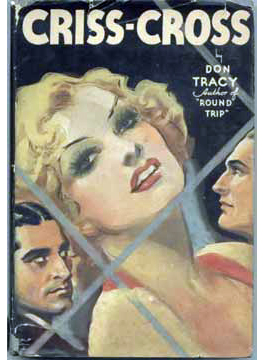 A less famous example comes from 1934, Don Tracy’s novel Criss-Cross. Here an alienated loner finds that his long-ago girlfriend has married a local crook. To get her back, the hero agrees to be the inside man in a robbery of the armored truck he drives. The heist goes badly, with the hero shooting the gangster and getting shot himself. He’s acclaimed as a hero, but fate catches up with him when a blackmailer who knows the truth starts putting the squeeze on him. Where The Asphalt Jungle ranges across many characters’ knowledge in a fairly tight time span, Criss Cross restricts its point of view to the protagonist but traces his life over a long period. These storytelling options, ingredient to any narrative whatsoever, will shape how the heist plot is handled.
A less famous example comes from 1934, Don Tracy’s novel Criss-Cross. Here an alienated loner finds that his long-ago girlfriend has married a local crook. To get her back, the hero agrees to be the inside man in a robbery of the armored truck he drives. The heist goes badly, with the hero shooting the gangster and getting shot himself. He’s acclaimed as a hero, but fate catches up with him when a blackmailer who knows the truth starts putting the squeeze on him. Where The Asphalt Jungle ranges across many characters’ knowledge in a fairly tight time span, Criss Cross restricts its point of view to the protagonist but traces his life over a long period. These storytelling options, ingredient to any narrative whatsoever, will shape how the heist plot is handled.
Criss-Cross and The Asphalt Jungle show that we’re dealing with an exceptionally schematic plot pattern. For convenience we can distinguish five parts.
Circumstances lead one or more characters to decide to execute a heist (robbery, hijacking, kidnapping).
The initiators recruit participants.
As a group they are briefed and prepare their plan. They study their target, rehearse their scheme, or take steps to make it easier.
The heist itself begins and concludes.
The aftermath of the heist, failed or successful, shows the fates of the participants.
There are other conventions, nicely laid out by Stuart Kaminsky in 1974 and more recently by Daryl Lee. But I’ll just concentrate on this structure and how it governs narration, because these aspects show very clearly the constant dynamic of schema and revision in the filmmaking tradition.
Four capers, mostly unhappy
Criss Cross (1948).
Four films in the period covered in my book point toward the heist genre, though only one became a core instance. The presence of a “consolidating” film might be one way genres emerge.
The earliest candidate is an unlikely one. In 1941 Laura and S. J. Perelman mounted a notably unsuccessful play called The Night Before Christmas, a farce in which crooks buy a luggage store in order to tunnel from its basement into the bank vault next door. Although Paramount was a backer of the stage show, Warners bought the rights and revamped it for Edward G. Robinson, who had had success in gangster comedies like A Slight Case of Murder (1938). The adaptation, Larceny, Inc. (1942) maintained the premise but revised the plot, multiplying the complications that face the leader Pressure and his two minions. The twist is that thanks to Pressure’s daughter, who’s unaware of the scheme, business starts booming and the crooks find themselves prosperous businessmen. Woody Allen swiped the premise for his Small-Time Crooks (2000).
Just as we don’t expect a comedy to be the initial entry in a genre mostly associated with drama, we might expect that the early entries in the genre would be the tidiest, with complex variations building on them. Actually, two precursors of The Asphalt Jungle display remarkable complexity.
The simpler one, Criss Cross (1948), starts late in the preparation phase: the night before the caper, when the gang is holding a party to distract a local cop who has his eye on them. We learn that Steve is working with Slim’s wife Anna to double-cross the gang. The next day, Steve is driving the armored car and recalling how he got into this situation. A flashback provides the circumstances for the robbery—Steve’s pursuit of Anna, her marrying Slim, and Steve’s impulsive proposal of a robbery to protect Anna from Slim’s punishment.
Next comes the planning phase. The robbers assemble and the task is reviewed by a mastermind they hire. This second flashback ends and, back in the present, we see the heist itself. The aftermath of the bloody robbery shows Steve in the hospital, honored by the community. A thug kidnaps him and takes him to Anna. Slim has survived the gun battle and finds the couple; he kills them before he is mowed down by the police.
Early as Criss Cross is in the history of the film genre, the plot components are already being scrambled. Thanks to 1940s Hollywood’s commitment to flashbacks and character subjectivity, the novel’s linear action gets fractured, compressed, and stretched. Moreover, in most films, the decision to pull the heist is made fairly early. Here and in the novel, circumstances slowly force Steve to rescue Anna from the man who mistreats her. The buildup to this decision consumes nearly fifty minutes of an 87-minute movie. Similarly, the aftermath of the heist is quite protracted, running about twenty minutes. And whereas other films (and novels) dwell on the recruitment of thieving talent, here this is elided. That’s because the other members of the gang are less significant than the central triangle of Steve, Anna, and Slim.
The Killers (1946) is even more complex because it clamps the block construction of Citizen Kane onto the heist schema. We start with one bit of the heist aftermath: the death of the gas-station attendant Ole. Like Kane, who also dies in his bed at the start of his film, Ole is the protagonist of the past-tense story. We next meet the protagonist of the present-time story, the insurance investigator Riordan, who functions like the reporter Thompson in Kane, and sometimes even gets the same silhouette treatment.
The rest of the film splits up the basic parts of the heist schema, rearranges their order, and presents them through a series of several flashback blocks, anchored in six characters’ testimony.
The heist itself is very brief, running only about two minutes, and the planning phase is only a little longer. As in Criss Cross, the leadup and the aftermath constitute the bulk of the film, but these phases are broken up into many bits, and these are often shuffled out of chronological order. We see Ole’s discovery by Big Jim years after the heist and then we see Ole, days after the heist, distressed that his lover Kitty has betrayed him. Similarly, a crucial event after the heist—Ole’s stealing the loot from the gang—precedes a scene before the heist in which he learns the gang is planning to double-cross him. We have to reconstruct the canonical sequence, from circumstance to aftermath, out of fragments revealed in testimony taken by Riordan.
Critics haven’t taken Criss Cross and The Killers as the first core instances of the heist film, perhaps because these movies complicate the classic plot template. In addition, they downplay the planning and execution phases. The heist scenes are relatively minor compared to the time devoted to other phases, particularly the circumstantial buildup. Moreover, the robber teams aren’t vividly characterized and don’t display a range of expertise. The emphasis falls on Steve and Ole, both played by Burt Lancaster, as the beautiful losers who become suckers for treacherous women and their brutal men.
By contrast, the linearity of The Asphalt Jungle throws the plot template into crisp relief. Both novel and film offer a full-blown enactment of central features picked out by Stuart Kaminsky. The gang, despite low social standing, has many skills. They’re held together by a leader who may also be a brainy planner. The robbers’ plan requires “skill, practice, training, and above all, perfect timing.” The gang’s resourcefulness is tested by accidents. The caper is partly successful but largely a failure, often through sexual weakness on the part of some players.
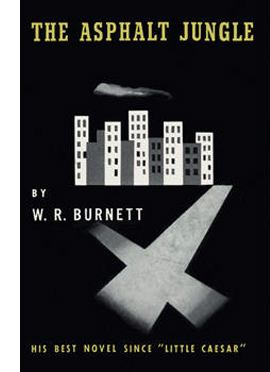 W.R. Burnett’s book opens up the wide narrative possibilities of the genre, thanks to an expanded group of characters. Where Don Tracy’s novel Criss Cross confined itself to relatively few figures, Burnett innovates by developing no fewer than eighteen distinct individuals, all somehow connected to the jewel robbery. New roles are assigned that will be staples of the genre—financier, go-between, bent cop, owner of a safe house. We see policemen of all ranks, a news reporter, the master mind Dr. Riedenschneider, the fixer Cobby, the bankroller Emmerich (who has a wife, a mistress, and a hired detective), and the four men on the team, two of whom have women attached.
W.R. Burnett’s book opens up the wide narrative possibilities of the genre, thanks to an expanded group of characters. Where Don Tracy’s novel Criss Cross confined itself to relatively few figures, Burnett innovates by developing no fewer than eighteen distinct individuals, all somehow connected to the jewel robbery. New roles are assigned that will be staples of the genre—financier, go-between, bent cop, owner of a safe house. We see policemen of all ranks, a news reporter, the master mind Dr. Riedenschneider, the fixer Cobby, the bankroller Emmerich (who has a wife, a mistress, and a hired detective), and the four men on the team, two of whom have women attached.
The novel lays out the canonical action phases with surgical efficiency. But as in the films I’ve just mentioned, the planning and the heist itself take relatively little space. Given so many characters’ contribution to the action, their gradual convergence and their dispersed fates dominate the book. Over a hundred pages are devoted to setting up the circumstances and recruiting the gang. The aftermath, tracing the outcome for all involved, runs another 140 pages.
The film adaptation retains the novel’s scope, trimming only a couple of minor characters. It moves briskly among the ensemble, attaching us to several in turn, so we know more than any one character does. The narration creates parallels among the team members and their affiliates (such as four women of different classes, with varying commitments to their men).
The result is something of a network narrative, a cross-section of several people whose lives change because of the robbery. There’s no clear-cut protagonist like Steve in Criss Cross. Dr. Riedenschneider has the most screen time, but the film begins and ends with the hooligan Dix, and the fate of both men dominates the climax. I point out in Reinventing Hollywood that a multiple-protagonist film often gives extra weight to one or two characters.
50s and 60s stylings
Violent Saturday (1955).
With The Asphalt Jungle as a robust prototype, writers and filmmakers developed the heist plot throughout the 1950s and 1960s. Despite his clumsy style (”He nodded with his head”), Lionel White became known as “the king of the caper novel” for his tireless variants on robberies, hijackings, and kidnappings. The other major figure was the far superior Donald Westlake, who wrote brutal heist tales as “Richard Stark” and comic ones under his own name.
In the comic register, Westlake was beaten to the post by heist films from England. The Lavender Hill Mob (1951) showed a timid clerk engineering the theft of gold bullion, which he disguises as kitschy miniature Eiffel Towers. The Lady Killers (1955) centered on a gang fooling their landlady into thinking that their planning meetings are actually string-quartet sessions. In Italy, the classic Big Deal on Madonna Street (I soliti ignoti, 1958) showed five incompetents trying to break into a pawnshop safe.
Big Deal was considered a parody of a much more serious film, one that was by then a landmark: Rififi (Du rififi chez les hommes, 1955). It did a great deal to consolidate the genre in France, along with Touchez pas au grisbi (1954) and Bob le flambeur (1956). (Both The Killers and Criss Cross had been imported in the Forties.) In England, the heist drama was seen in The Good Die Young (1954), while in the US there were 5 Against the House (1955), Violent Saturday (1955), Plunder Road (1957), The Big Caper (1957, from a White novel), and Odds Against Tomorrow (1959). The year 1960 saw a remarkable number of releases, with The League of Gentlemen (U.K.), The Day They Robbed the Bank of England, Seven Thieves, and most famously Ocean’s 11 (all U.S.).
Through the 1960s the genre proliferated, including a remake of The Asphalt Jungle (Cairo, 1963), Jules Dassin’s near-self-parody of Rififi (Topkapi, 1964), and a string of heist films that mixed in romantic comedy (e.g., Gambit, 1966; How to Steal a Million, 1966). The Italian Job (1964) became a cult movie, with tourists visiting the sites of shooting in Turin. The genre has remained robust throughout world cinema ever since.
The very rigidity of its format and the constraints it lays down, have allowed for ingenious innovations. I’ll sample some of those from the genre’s first dozen or so years, concentrating on three areas: the differing emphasis given to the plot phases; variants of point-of-view; and manipulations of time.
Where’s the action?
Rififi (1955).
The Asphalt Jungle offers a fairly pure geometry: the heist, lasting about eleven minutes, ends just before the film’s midpoint. On the other side of that is another big scene: a gunfight initiated by Emmerich’s henchman Brannom when Dr. Riedenschneider and Dix bring in the loot. That confrontation takes another seven minutes, so the heist and its immediate wrapup sit at the center of the running time. What led up to the heist, the circumstances, recruitment, and planning phases, consume the first forty-five minutes of the film, and the aftermath of the heist, affecting the surviving characters, will take just about as long. This balanced geometry, putting the heist snugly at the center of the plot but devoting most time to showing many lives leading up to and away from the crime, suits the extensive characterization of all involved.
This is a neat structure, but not the only possibility. Any phase of the action can be given great weight. The first half hour of Bob le flambeur is an episodic introduction to Bob’s routines and associates. It’s the circumstantial phase—he’s running out of money—presented at low pressure, emphasizing instead the fascinating milieu Bob coolly drifts through. Only when Roger points out a croupier at the Nantes casino does Bob formulate “the job of a lifetime.” Then crew assembly and planning can begin. As the plot develops, characters and relationships presented casually in the exposition become crucial to the heist and its unraveling.
Other phases can be stretched out. Ocean’s 11 dwells on the phase of gathering the talent. Before the start, Danny Ocean has already conceived the heist, but we aren’t told the plan. Instead we watch his team members converge on Las Vegas. Not until the film’s midpoint, at 53:00, is the plan revealed in a briefing. The dawdling exposition suits a film about cool guys hanging out.
The formation of the crew is exceptionally protracted in Odds Against Tomorrow, because here two members hesitate about participating. The racist Earl Slater, wracked by the shame of not providing for his wife, finally gets her to agree to let him join. Not until twenty-three minutes from the end does the African-American musician Johnny Ingram finally accept a role in the heist, which immediately becomes the film’s climax.
The source for Odds Against Tomorrow (one of the better heist novels) handles the basic pattern very differently, putting the heist just before the midpoint and devoting the second half of the book to the increasingly hopeless getaway, where the interracial tensions play out at length.
The planning phase sometimes includes a rehearsal for the heist, and that may require a subsidiary crime, such as stealing keys or a vehicle. The League of Gentlemen has an unusually long planning phase, in which the gang masquerades as soldiers in order to seize weapons from a military post. This robbery, running nearly twenty minutes, takes longer than the film’s main heist but serves to demonstrate the team’s resourcefulness and esprit de corps. The men’s precision and resourcefulness (based on their wartime experience) lead us to expect a successful main event.
Kaminsky suggests that the big-caper genre resembles the soldiers-on-a-mission movie, which centers on the details of a process executed by skillful specialists. That display of process comes to the fore in The Asphalt Jungle’s central robbery, which initiated the convention of detailing the mechanics of the heist. Other films expanded the heist sequence to larger proportions than was evident in The Killers or Criss Cross. Rififi became the model; its heist runs twenty-five minutes without any words being spoken. (That sequence is part of an even longer wordless stretch that runs over thirty minutes.) Dassin’s film meticulously breaks down the steps of a complicated robbery, allowing us to appreciate the men’s clever planning while, as usual, ratcheting up moments of suspense when it appears they might fail.
After Rififi, heist scenes got longer and more intricate. The one in Big Deal on Madonna Street runs twenty minutes, those in Seven Thieves and The Day They Robbed the Bank of England run thirty minutes, and those in Topkapi and The Italian Job approach forty minutes. To motivate these long, virtuosic passages, there need to be many obstacles, many ingenious ways around them, and many characters concentrating on their assigned duties.
Long or short, the heist can be shifted off-center. The heist can be the climax, as in The Big Caper, or it can be virtually the film’s entire second half, as in The Italian Job (which arguably doesn’t complete the heist and so never provides a proper aftermath). Topkapi’s flamboyant robbery, involving elaborate subterfuges, dominates the film’s latter stretches, leading to a quick reversal in its epilogue. The heist is finished early on in The Lady Killers, since the crucial action is the long aftermath in which, contradicting the title, the crooks dispose of one another. By contrast, the heist dominates nearly all of Larceny, Inc. Most of the film is devoted to the crooks’ slowly deepening tunnel, as the process is interrupted by breaks in the water main, a geyser of furnace oil, and their decision to abandon their plan in favor of going straight—before another crook comes along to continue the caper.
Or the heist can launch the film. In Plunder Road, after the train robbery is completed, the rest of the film is the aftermath, consisting of chases and suspense sequences. The circumstances, recruitment, and planning phases are alluded to in dialogue, as suits a low-budget production. The plot of Touchez pas au grisbi starts the morning after the caper and shows thieves trying to protect their loot from a treacherous drug dealer. It was probably inevitable that somebody would make a heist movie that keeps the heist offscreen and makes the action one long aftermath.
Steering the moving spotlight
Topkapi (1964).
Many films based on mystery rely on restricting a character’s range of knowledge, as in detective novels told in the first person. But suspense, Hitchcock and others recognized, relies on greater access to story information. If there’s a bomb under the table, Hitch advised, tell the viewer but don’t tell the characters. The heist film, as an account of how a crime is committed, depends more on suspense than mystery. So we’d expect a constant shuttling from character to character, filling us in on how the scheme is going and letting us worry about impending dangers.
This is generally what we find. Criss Cross is unusual in confining us to what Steve knows about Anna’s and Slim’s real agendas, and this confinement is what yields the surprises that pop up in the film’s final stretches. Mostly, though, heist movies and novels use omniscient narration. Employing what I call in Reinventing Hollywood the “moving spotlight” approach, the film shifts us from attachment to one character to another.
The moving spotlight permits us to understand the choreography of the crime, in which many characters play a part, and to feel suspense when matters of timing or accident intrude. Indeed, the convention of the unforeseen accident that spoils the heist relies on our breaking attachment to the crooks and getting privileged access to the off-schedule night watchman, the passing witness, or the failed piece of machinery. In Topkapi we and not the thieves learn how a stray bird will upset their getaway.
This omniscient narration (which need not tell us absolutely everything) can be deployed in a range of ways. One option is chapter titles, as in Big Deal on Madonna Street (and revived by Tarantino in Reservoir Dogs). A more common resource is the non-character narrator, present as an authoritative voice-over. In Bob le flambeur, a worldly male voice introduces us to Bob’s daily routine and comments somewhat cynically on his place in his milieu.
A similar all-knowing voice introduces us one by one to the heisters in The Good Die Young; there it eases the transition into expository flashbacks. Topkapi treats this convention, as others, with self-conscious playfulness. At the beginning the beguiling woman in the gang addresses the camera and explains that the heist aims to get the emerald she covets. She doesn’t take this narrating role again until the very end, in a brief epilogue that replays the gathering of the gang in stylized form.
Heist films must often choose whether to widen the field of view to include either the cops or civilians. Armored Car Robbery (1950), for me a peripheral instance of a heist film, alternates the gang’s activities—which do pass through the phases I’ve outlined—with the detectives’ investigation. The result is balanced between heist film and police procedural. Something similar happens in Violent Saturday (1955), which devotes most of its plot to a gang’s scheme to rob a mining town’s bank. Crosscut with the gang’s gathering and planning are scenes showing several members of the community, each with domestic problems. These scenes, typical of small-town melodrama (dissolute rich people, sexy nurse, repressed librarian, lovelorn bank manager), not only pad out the film but show us characters who will be affected by the heist. Some become witnesses and bystanders during the robbery, one is killed, and one, a local mining manager, will be forced to fight the gang at the climax.
The timing and selection of the shifts among characters can build up specific effects. For instance, in Big Deal on Madonna Street, the heist is conceived by Cosimo, a hardheaded crook doing time. A handful of would-be crooks decides to execute the robbery without him. We know, as the gang does not, that he has been released and is conspiring to interfere. The filmmakers could have made Cosimo’s return a surprise revelation, but instead our expectation that he’ll start meddling intensifies our interest.
Similarly, we know, as the Topkapi gang does not, that Arthur is a police spy. But then he confesses to them, so we know, as the Turkish police do not, that he is to be a double agent. The film milks suspense during the scenes in which Arthur relays information to the authorities, and then it makes us wonder how the gang will use their new knowledge of police surveillance. This is the sort of fine-tuned choice about “who knows what when” that heist films must make at every turn.
At a more granular level, when the spotlight is on one character, the filmmakers must choose whether to make those moments, shot by shot, highly restricted or not. In The Killers, Nick Adams’ account of Ole’s reaction to the stranger stopping for gas is more or less plausibly limited to Nick’s ken. But the precise exchange of glances between the driver and the Swede signal to us that Ole has been recognized. Nick doesn’t register this, since he’s standing at the rear of the car (barely visible in my first still, over Ole’s right shoulder).
In effect, this is a narrational aside to the audience. Nick can’t see this significant exchange of glances, and his voice-over doesn’t specify it, so we can’t assume Riordan learns of it. But this privileged moment primes us to see Big Jim as a major menace in scenes to come. This sort of deviation from what a character could plausibly know or notice is common in cinematic narration and differentiates it from literary narration, which is more tightly restricted in handling “point of view.” Classical Hollywood is biased toward unrestricted narration; radical restriction is rare. The heist genre can exploit many fine gradations between attachment to a character and more wide-ranging knowledge.
What’s our clock?
The Killing (1956).
As we’ve seen, two early instances of heist films break with a linear layout of the story. Criss Cross presents what Reinventing Hollywood calls a crisis structure, beginning just before the turning point and flashing back to show what led up to it. The Killers has a refracted narration, with all of the past events passed to the investigator Riordan and us through witnesses’ testimony. The flashbacks in Criss Cross are chronological, but those in The Killers are drastically out of order.
Time-scrambling, then, seems to be especially welcome in the heist film (as not, say, in the Western). The basic plot pattern is such a simple one that shuffling phases or parts of phases doesn’t create confusion. Yet few films of the 1950s I’ve found display the complexity of the Forties examples. Indeed, a time-juggling heist novel, The Lions at the Kill (Simon Kent, 1959) was ironed into straightforward linearity in the film version, Seven Thieves.
The Good Die Young displays a more complicated structure. It begins at a point of crisis, with four men driving in a car to the site of the caper.
The voice-over narrator introduces each man in turn, and then a long flashback explains his backstory. Deprived of information about the heist, we have to wonder how the narration will bring the men together and create their plan.
After the long section explaining each man’s circumstances, all involving women and money, the flashbacks meld. The men gradually come to know each other through frequenting the same pub. Their desperation pushes them toward accepting one man’s proposal that they rob a post office. With so much time spent on preparation and assembly, the actual planning is necessarily brief. Eventually the final flashback flows seamlessly into the present-time situation, initiating a brief replay of the dialogue in the car that opened the film. The heist (devolving into a disastrous gun battle) initiates the climax, and an airport aftermath concludes the film.
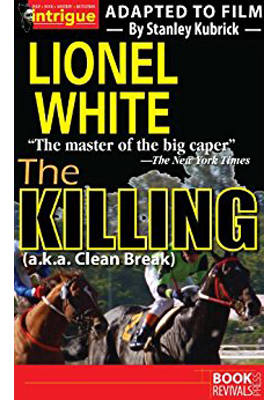 The most ambitious 1950s recasting of the nonlinear efforts of the 1940s films is The Killing (1956). The source novel, Lionel White’s Clean Break (1955) consists of interwoven threads. A crook, his pal, a cashier, a bartender, and a crooked cop conspire to rob a racetrack. They will employ helpers to start a fistfight and shoot a racehorse. The early chapters devote short stretches to following each one, already recruited, through the circumstances phase of the heist template. The men assemble at their planning meeting, which is invaded by the snoopy wife of the weak cashier. She then tells her boyfriend about the heist, so another strand involving other characters is introduced.
The most ambitious 1950s recasting of the nonlinear efforts of the 1940s films is The Killing (1956). The source novel, Lionel White’s Clean Break (1955) consists of interwoven threads. A crook, his pal, a cashier, a bartender, and a crooked cop conspire to rob a racetrack. They will employ helpers to start a fistfight and shoot a racehorse. The early chapters devote short stretches to following each one, already recruited, through the circumstances phase of the heist template. The men assemble at their planning meeting, which is invaded by the snoopy wife of the weak cashier. She then tells her boyfriend about the heist, so another strand involving other characters is introduced.
On the day of the robbery, White’s narration again attaches itself seriatim to each man as he executes his role in the scheme. While the early part of the book had a few mild jumps back in time to follow each heister, the day of the job creates extreme back-and-forth shifts. We follow the bartender, for instance, going to the track on the fateful day, before the next subchapter skips back to the cashier waking up and then going to the same train. In a later section, we skip back to the previous day and attach ourselves to the sniper who will shoot the racehorse. Because of the overlapping lines of action, the shooting of the horse and the starting of the bar fight are presented twice. Everything eventually converges on Johnny Clay, the mastermind, who breaks into the money room and steals the day’s revenue.
These temporal overlaps emerge partly from the description of the action, but they’re also marked by either characters looking at clocks or watches, or by explicit mention in the prose, such as “It was exactly six forty-five when…”
The film version makes these overlapping schedules much more explicit. A detached voice-over describing police routine or criminal behavior had become a commonplace in the 1940s, in both “semidocumentary” films and in radio drama, notably Dragnet. In The Killing, apart from lending an aura of authenticity, the voice-over exaggerates the time markers of the novel by introducing scenes crisply. The first five scenes are introduced with these tags:
“At exactly 3:45…”
“About an hour earlier…”
“At seven PM that same day…”
“A half an hour earlier…”
“At 7:15 that same night…”
These lead-ins remind us of the ticking clock, set up parallels among the characters, and get us acclimated to the film’s method of tracking one character, then jumping back in time to track another. This is moving-spotlight narration on markedly parallel tracks. The same method will be applied during the heist, when ten consecutive scenes and several others will be tagged in the same way. (“Mike O’Reilly was ready at 11:15.”)
It’s not just the repetitions that exaggerate White’s jagged time scheme. When the sniper Nikki is shot after plugging the racehorse, the narrator reports drily: “Nikki was dead at 4:24.” Cut to Johnny leaving a luggage store, and the voice-over announces: “At 2:15 that afternoon Johnny Clay was still in the city.”
The time jumps more or less buried in White’s prose are made dissonant in the film. Here the juxtaposition heightens the likelihood that Johnny’s robbery won’t go according to plan.
The replays are no less sharply profiled. As the scenic blocks move from character to character and skip back in time, they include actions we’ve already seen. The most persistent is the repetition of the track announcer’s calling the start of the crucial seventh race, but we also get replays of the wrestler Maurice starting a fight, the downing of the horse, and glimpses of Johnny waiting to slip into the cash room.
Instead of shuffling flashbacks in the manner of The Killers, The Killing offers brief time chunks stacked in slightly overlapping array until they all square up in a single moment, the consummation of the robbery. This structure allows for the sort of character delineation we find in The Asphalt Jungle while also offering the audience a formal game to enjoy. Kubrick’s film can be seen as pointing in two directions—revising the flashback format of the 1940s entries, but becoming a point of reference for later filmmakers eager to innovate games with time and viewpoint that would remain comprehensible to the audience.
The Killing helped make Clean Break White’s most famous novel. It was often republished under the film’s title. Perhaps in a grateful spirit White’s 1960 novel Steal Big (1960) included this scene.
Donovan didn’t look at the half-dozen worn, barely legible signs in the dingy lobby of the building. He went at once to the elevator and asked for the fifth floor. Getting out of the elevator, he turned left, took a dozen steps and knocked on a pebbled-glass door. The door bore the legend, KUBRIC NOVELTY COMPANY.
Mr. Kubric, it turns out, supplies illegal guns and explosives.
Art for artifice’s sake
Inside Man (2006).
White’s in-joke, along with The Killing’s gamelike approach to structure, reminds us that whatever its claim to realism, this is a highly artificial genre. The strict template and the ritualistic steps in it—recruiting the crew, casing the target, checking watches—invite filmmakers to tinker with self-conscious narration that lets the viewer in on the joke.
One convention, that of the rehearsal for the big job, is flaunted in Bob le flambeur, when the narrator simply breaks into the film with the line, “Here’s how Bob pictured the heist,” and we get a stylized, hypothetical enactment of the job carried off perfectly. In these films, when the rehearsal goes well, you know the real thing will face problems.
Something similar, though suited to light comedy, takes place in Gambit. Here we think we’re seeing the heist as executed (across twenty-three minutes), but it proves to be no more than the fantasy of the crook hatching it. Again, everything that succeeds in the fantasy goes wrong in reality.
As it gained a profile, the genre got reflexive. In the novel that was the source for The League of Gentlemen, the heisters explicitly model their plan on the one in Clean Break. The film version likewise sets its heisters mimicking a pulp novel, though it didn’t specify the title. And in The Wrong Arm of the Law (1963), Peter Sellers’ cockney mastermind promises to show his henchmen “educational films and training films” like Rififi, The Day They Robbed the Bank of England, and The League of Gentlemen.
The opportunities the genre provides for experimenting with story stratagems, sometimes in very self-conscious ways, seem to have been part of the reason later filmmakers tried their hand at it. In the 1990s and 2000s, writers and directors drawn to neo-noir and narrative experiment took up thriller conventions generally, and the heist film was one option.
In Reservoir Dogs (1992), Tarantino revived the shuffling of time and viewpoint that was ingredient to the genre. Although the film pays homage to Clean Break, its form is no less indebted to Criss Cross. Like that film, it flashes back from the day of the heist in order to run through the canonical phases of action. And as in The Killers, those phases are scrambled out of order. Brian Singer’s The Usual Suspects (1995) brings the (very ‘40s) device of the lying flashback to the genre, within the template of police questioning after the heist. Inside Man (2006) mixed to-camera narration, flashbacks, and flashforwards to interrogations after the crime.
Among Americans it’s Steven Soderbergh who has returned to the caper film most frequently. The Underneath (1995) is a remake of Criss Cross, with an extra layer of flashbacks. Logan Lucky (2017), with its deadpan redneck losers, joins the tradition of comic heist movies. Most strikingly, the Ocean’s series makes a virtual fetish of the male camaraderie and playful plot tricks typical of the genre. The films pepper the action with voice-overs, cunning ellipses, and flashbacks within flashbacks. The plots hide key information about the plan. They fill the action with in-jokes, such as a star cameo by Bruce Willis commenting on box-office grosses. Like 1960s films, they incorporate romantic comedy. In Ocean’s Eleven ((2001) Danny and Tess arrange a post-divorce reconciliation, and in Ocean’s Twelve (2004) Danny’s pal Rusty gets involved with police agent Isabel.
Piling up obstacles, reversals, bluffs, and double-bluffs, the films form a kind of anthology of the genre’s tricks. By the time we get to Ocean’s Thirteen (2007), the early phases of the standard plot schema can be given short shrift. We know the gang and its modus operandi, so the bulk of the film becomes a mind-bogglingly intricate heist including everything from planting bedbugs in a hotel room to manufacturing loaded dice in a Mexican factory under threat of strike. The network of rules and roles laid out in the 1950s—master mind, aged expert, financier, crooked helpers, allies and rivals and go-betweens and stooges—are given baroque elaboration and treated with an almost self-congratulatory panache.
So am I looking forward to Ocean’s Eight? It’s directed by Gary Ross, so I don’t expect Soderbergh’s casual sheen. And the target of the heist, a fashion show at the Met, may be a bit too on the nose; why can’t the ladies tackle a payroll or a munitions factory? Still, like a butterfly collector looking for new specimens, I’m quite curious. When it comes to narrative strategies, I’m a sucker for a fresh con.
Thanks to Jim Healy and Geoff Gardner for discussion of the genre.
Stuart Kaminsky’s American Film Genres: Approaches to a Critical Theory of Popular Film (Plaum, 1974) is a trailblazing study, and the chapter on the “big-caper” film is an indispensible starting point for studying this kind of movie. Later editions of the book eliminated this chapter. A wide-ranging recent survey is Daryl Lee’s The Heist Film: Stealing with Style (Wallflower, 2014). Alastair Phillips offers an in-depth analysis of a classic in Rififi (Tauris, 2009).
My quotations from Donald Westlake come from Murderous Schemes: An Anthology of Classic Detective Stories (Oxford University Press, 1996), pp. 1 and 126. I also found the entry on Lionel White in Brian Ritt’s Paperback Confidential: Crime Writers of the Paperback Era (Stark House, 2013) helpful. The “KUBRIC” passage in White’s Steal Big (Fawcett, 1960) is on p. 47. White much influenced Westlake, as I hope to show in a future entry, but Westlake was a far superior stylist, as I discuss a little in this entry. See also this note on Levi Stahl’s anthology of Westlake nonfiction.
For more on analyzing narrative see “Three Dimensions of Film Narrative” and “Understanding Film Narrative: The Trailer.” Tarantino’s debts to the 1940s are reviewed in this entry. See as well my recent entry on thrillers. I analyze the convoluted narrative of The Killers in Chapter 9 of Narration in the Fiction Film. The Way Hollywood Tells It: Story and Style in Modern Movies discusses 1990s filmmakers’ relation to the Forties. Multiple-protagonist plotting is considered in Chapter 3 of Reinventing Hollywood: How 1940s Filmmakers Changed Movie Storytelling.
The concept of schema and revision is considered here as applied to style; this entry, like Reinventing, applies it to narrative principles. My Dunkirk entry points out affinities between the overlapped time frames in The Killing and the three-track scheme Nolan gives us. Unlike Kubrick, Dunkirk applies the principle to the entire film and assigns each timeline a different duration, but it generates a back-and-fill organization and clusters of replays reminiscent of The Killing.
Burt Lancaster is considered here, and why not?
P. S. 26 March 2020: Thanks to Adrian Martin for correcting two slips in my account of Criss Cross!
Ocean’s Eight (2018).












